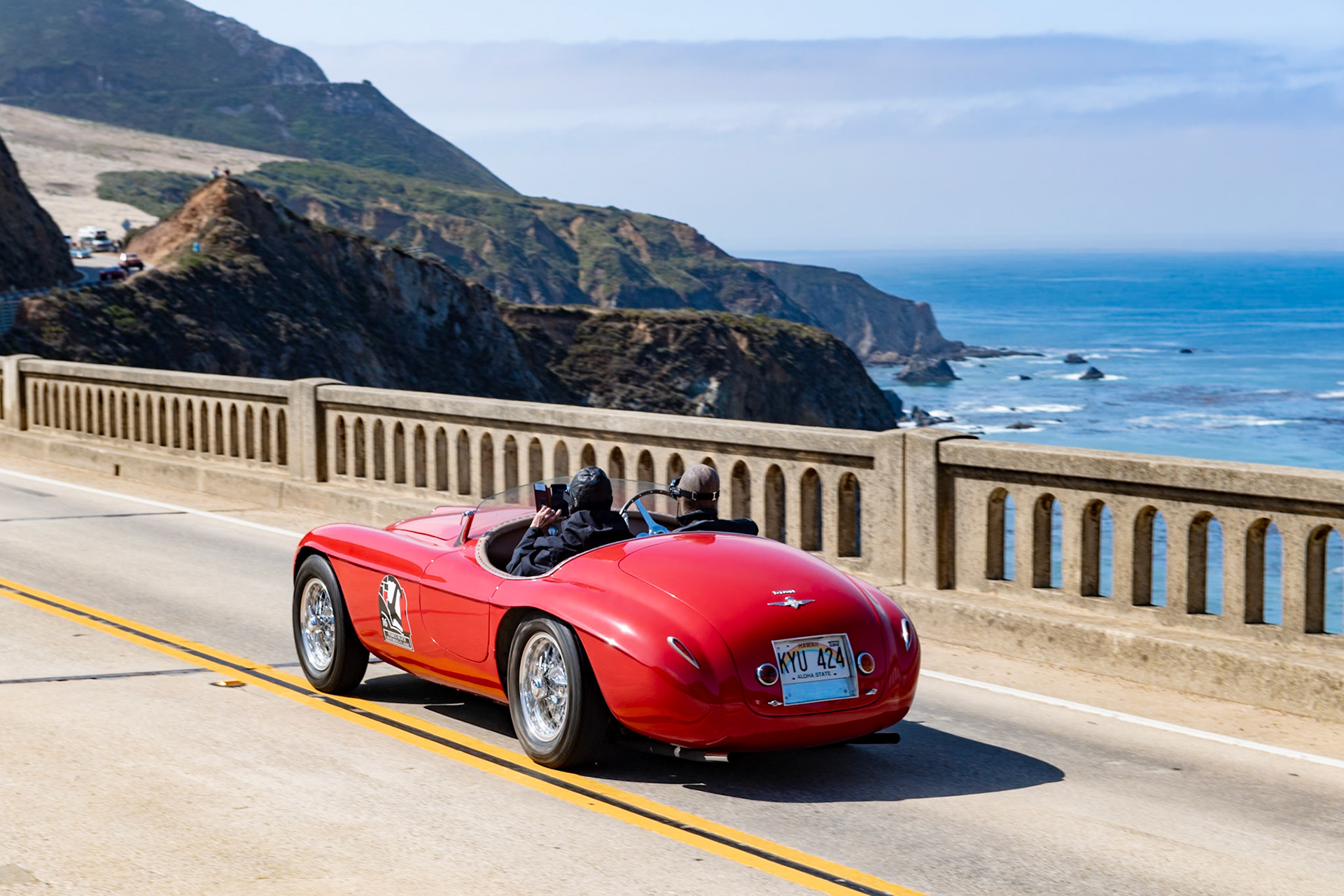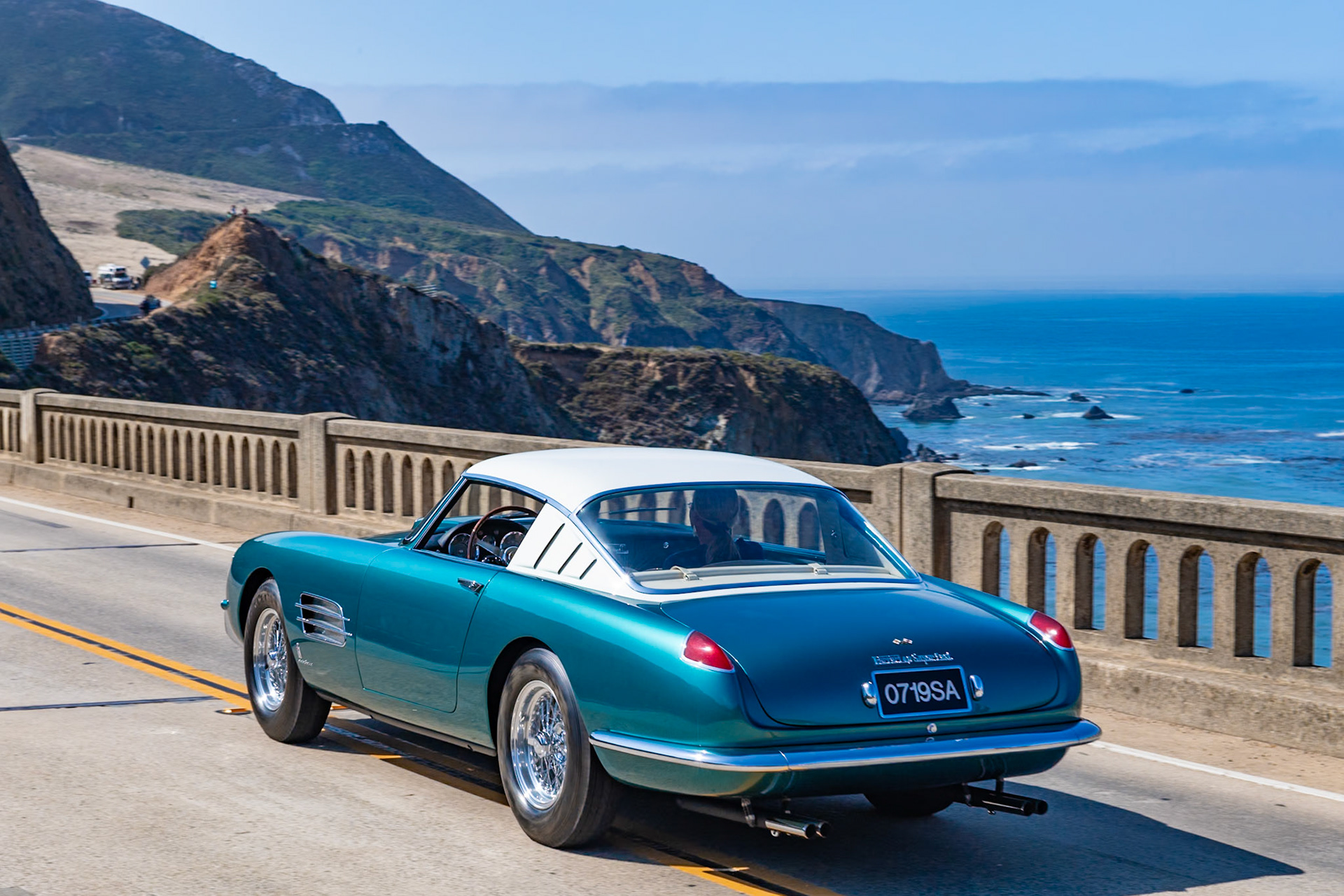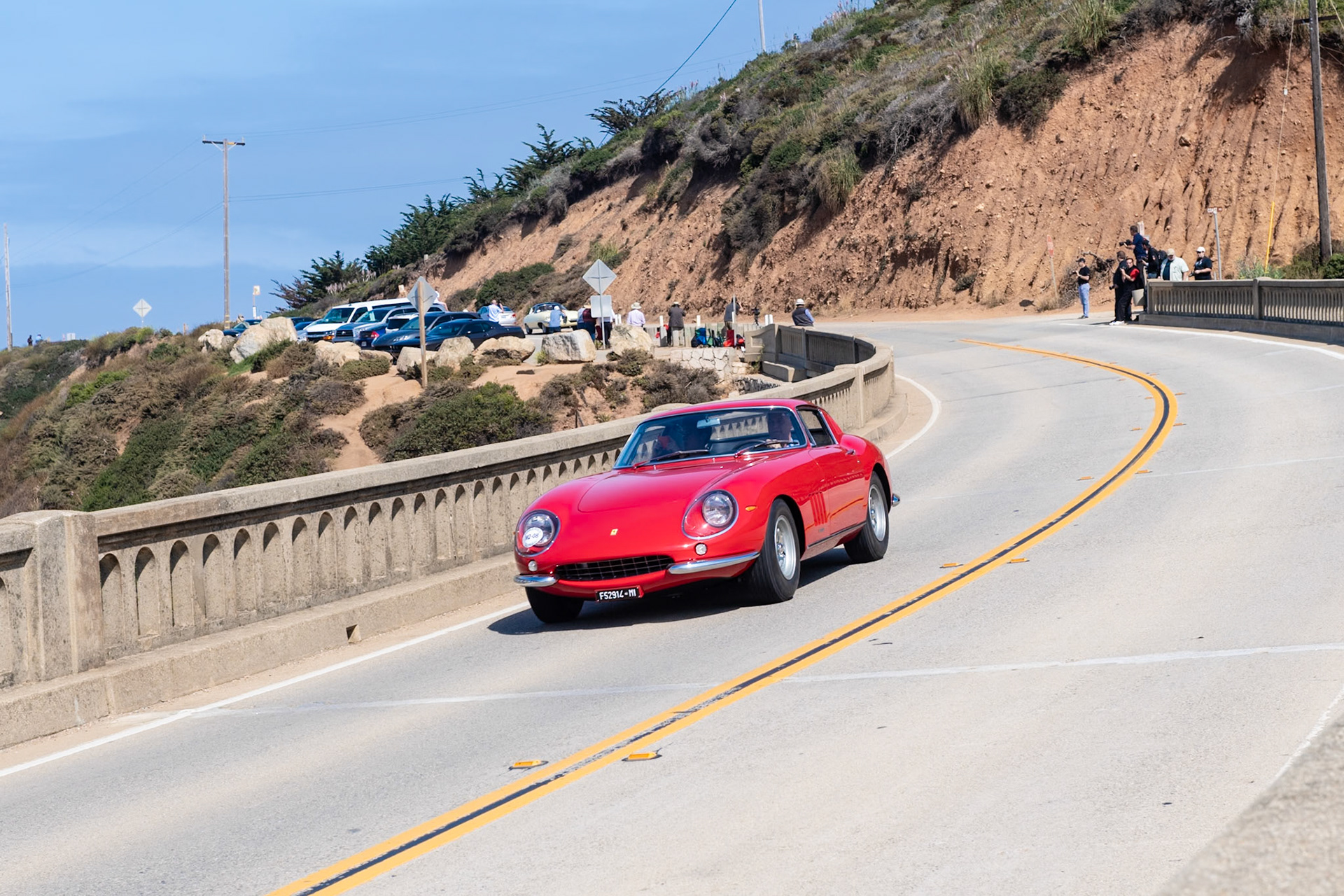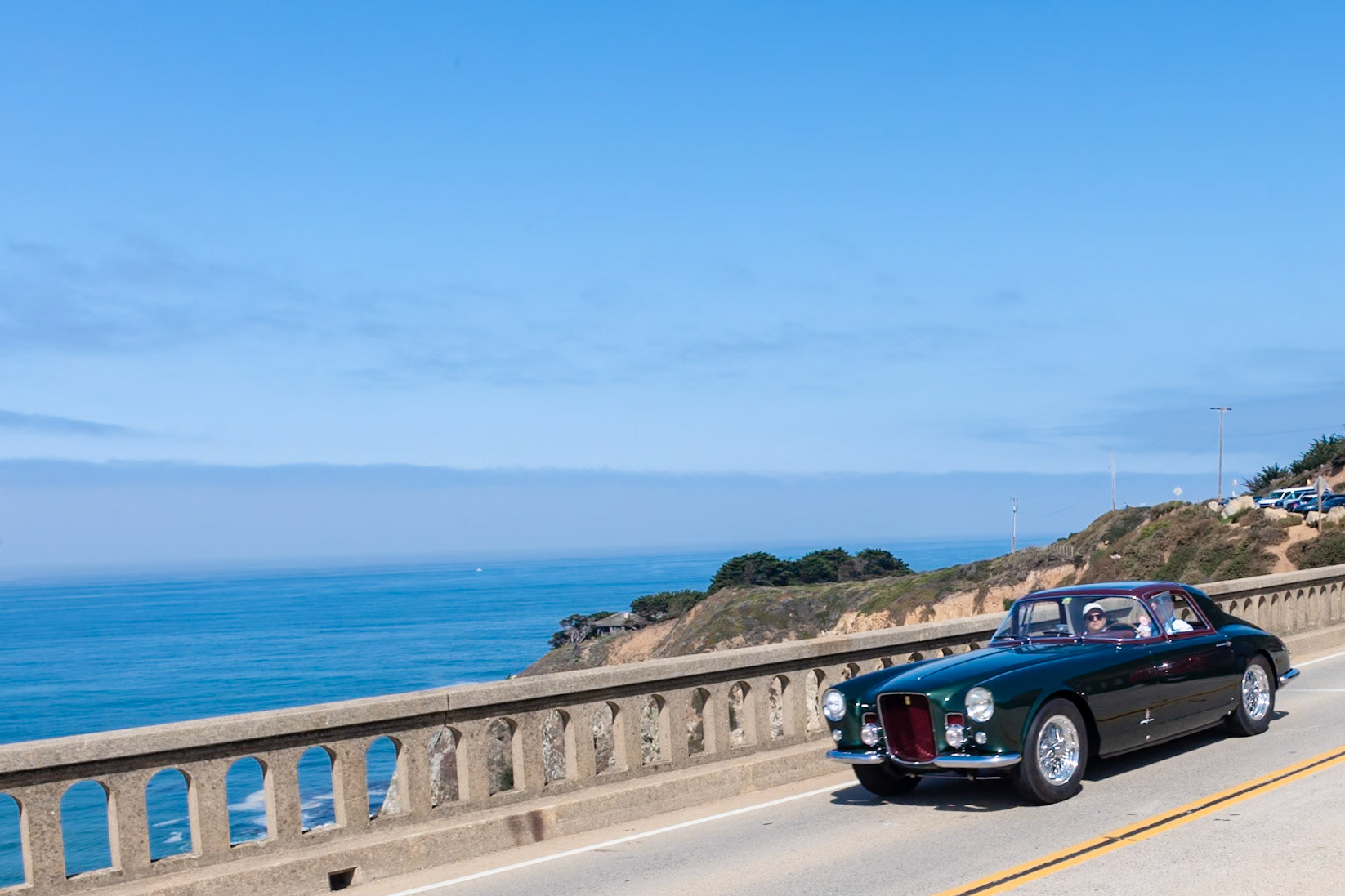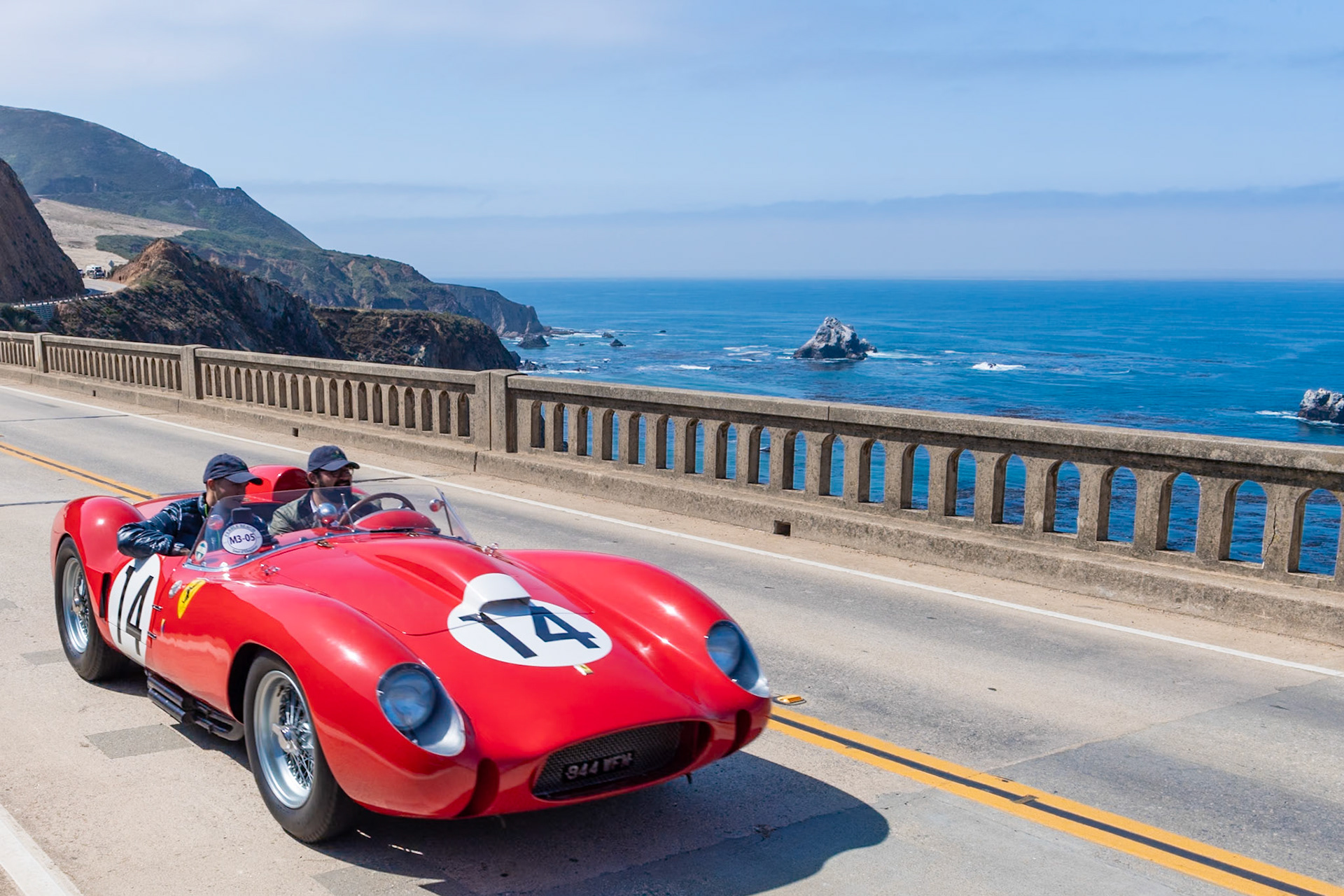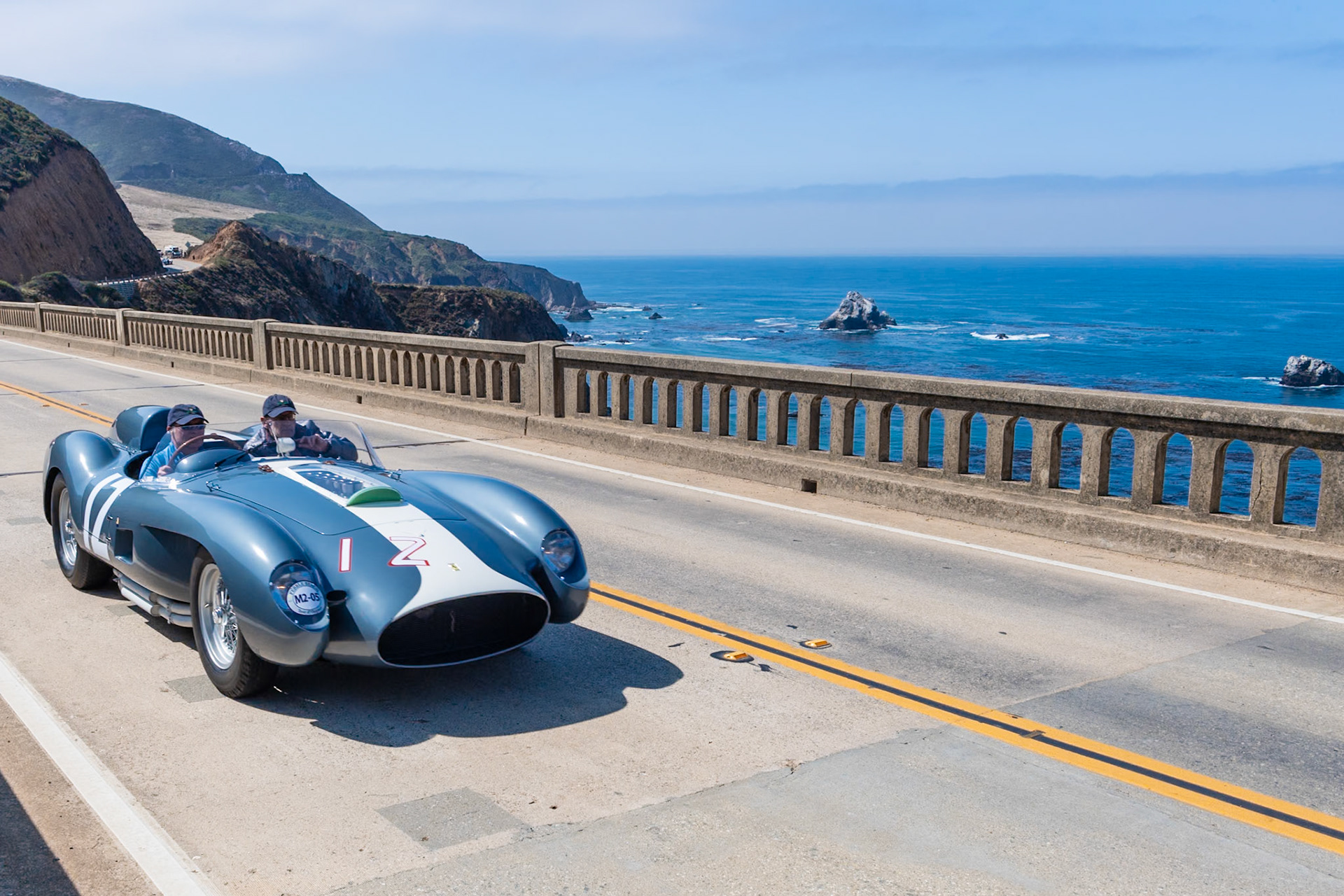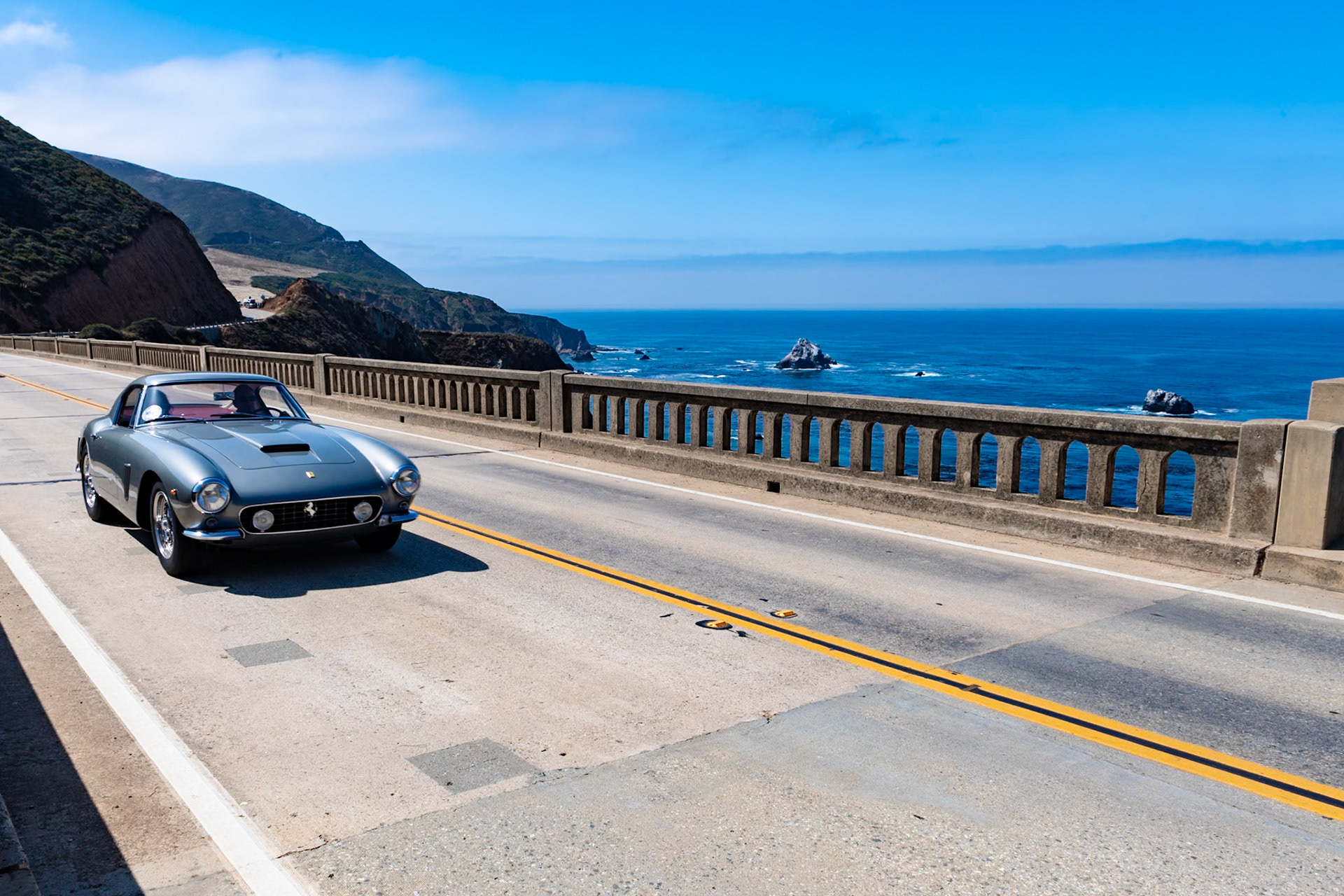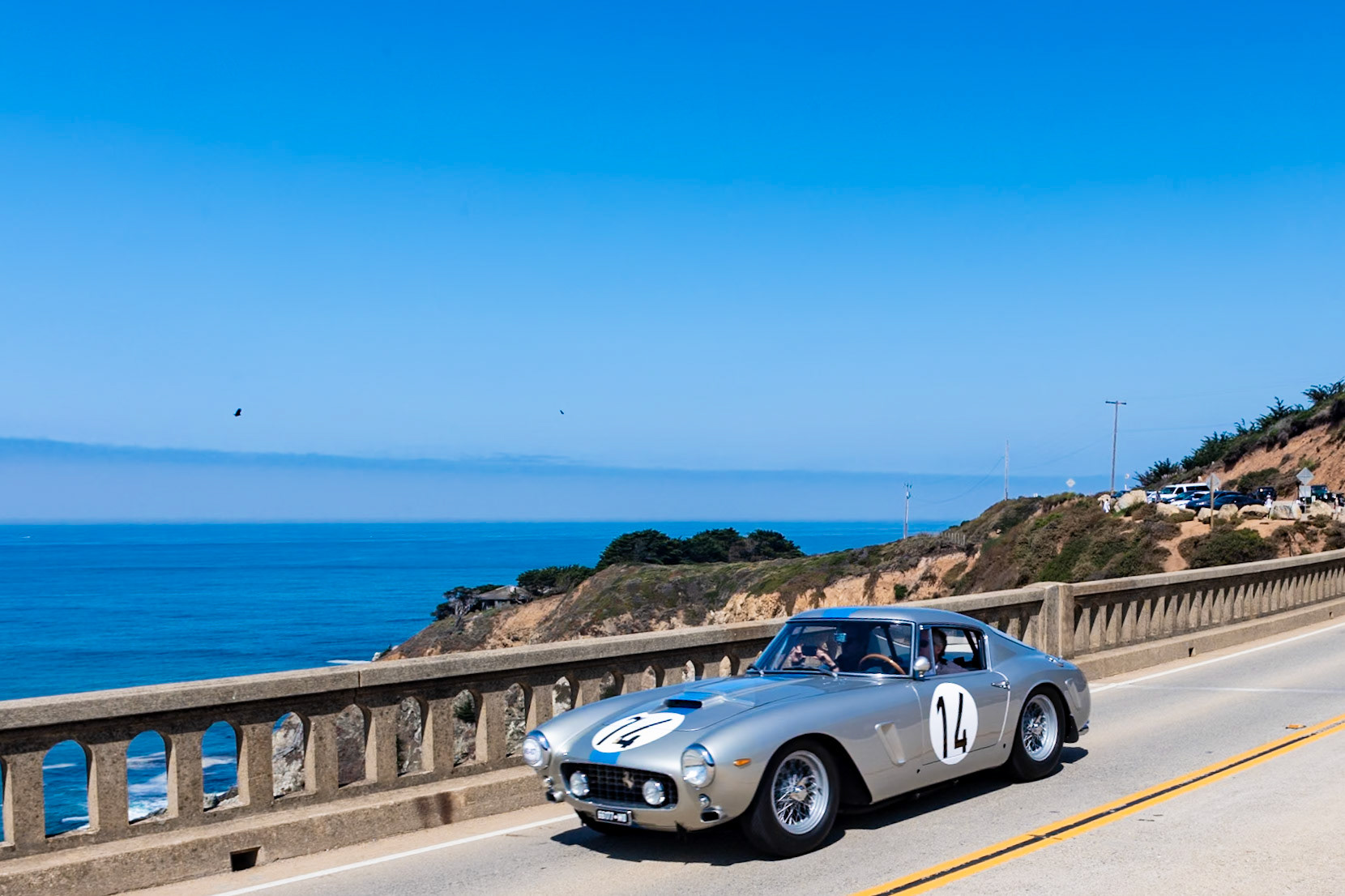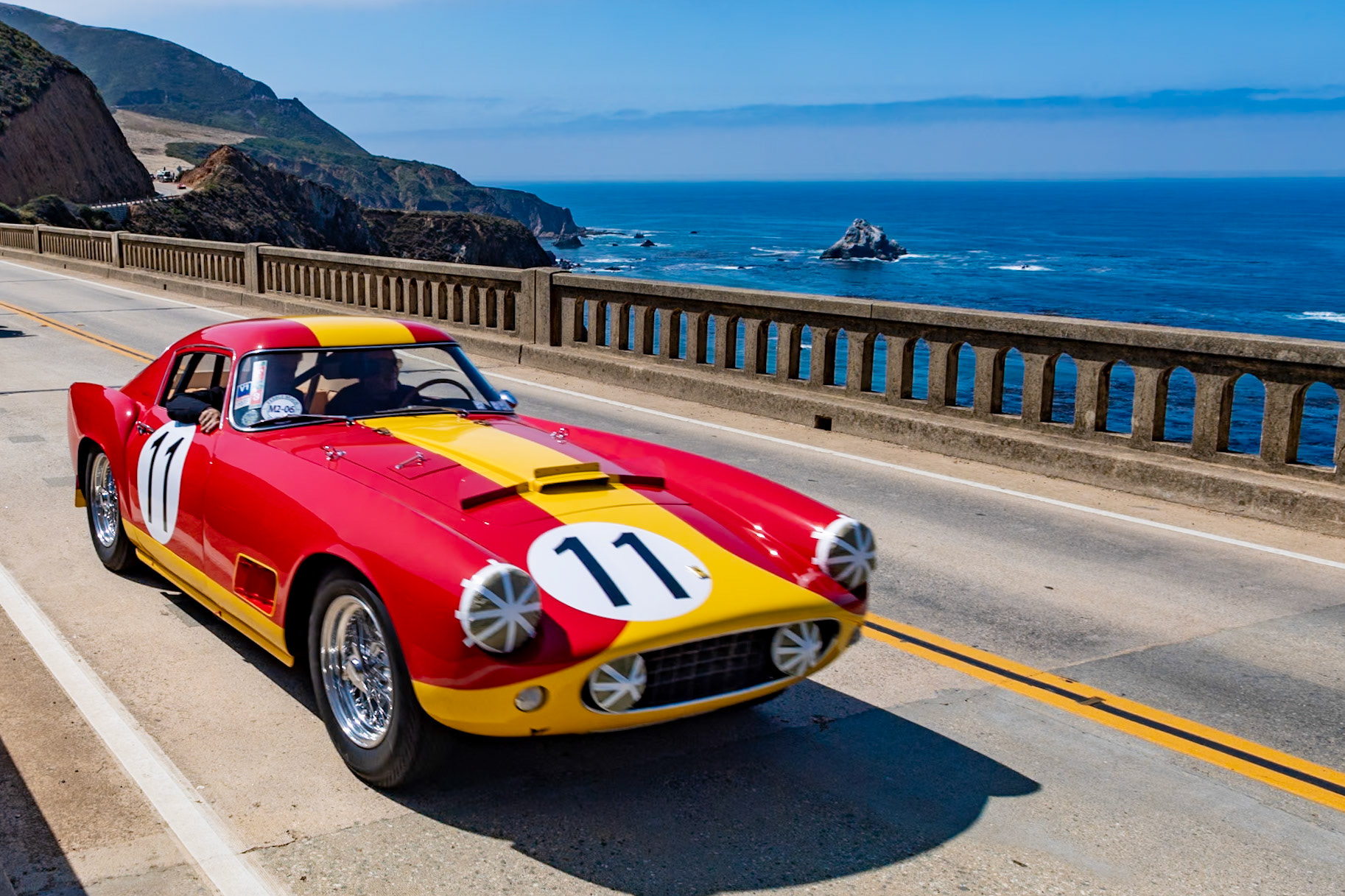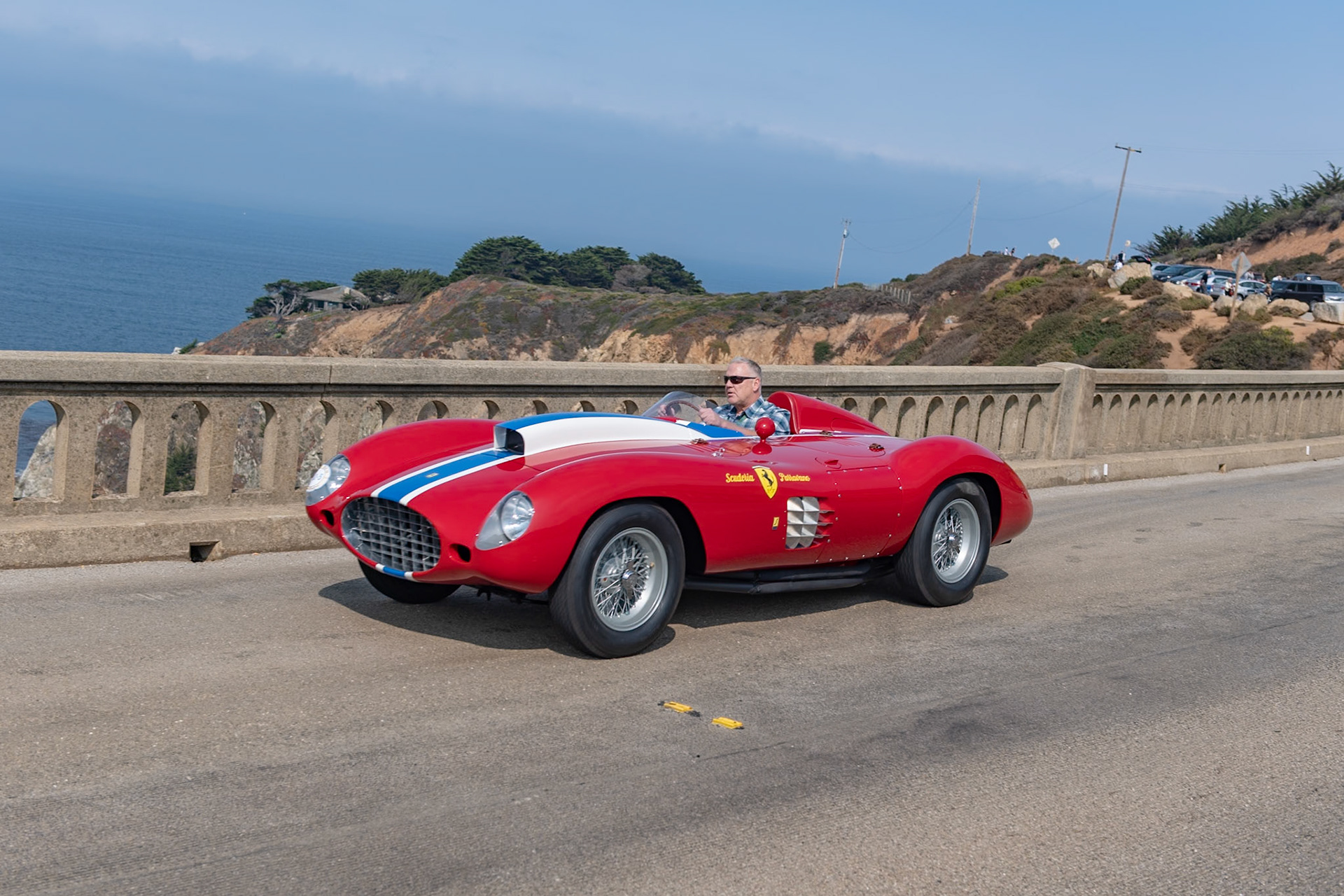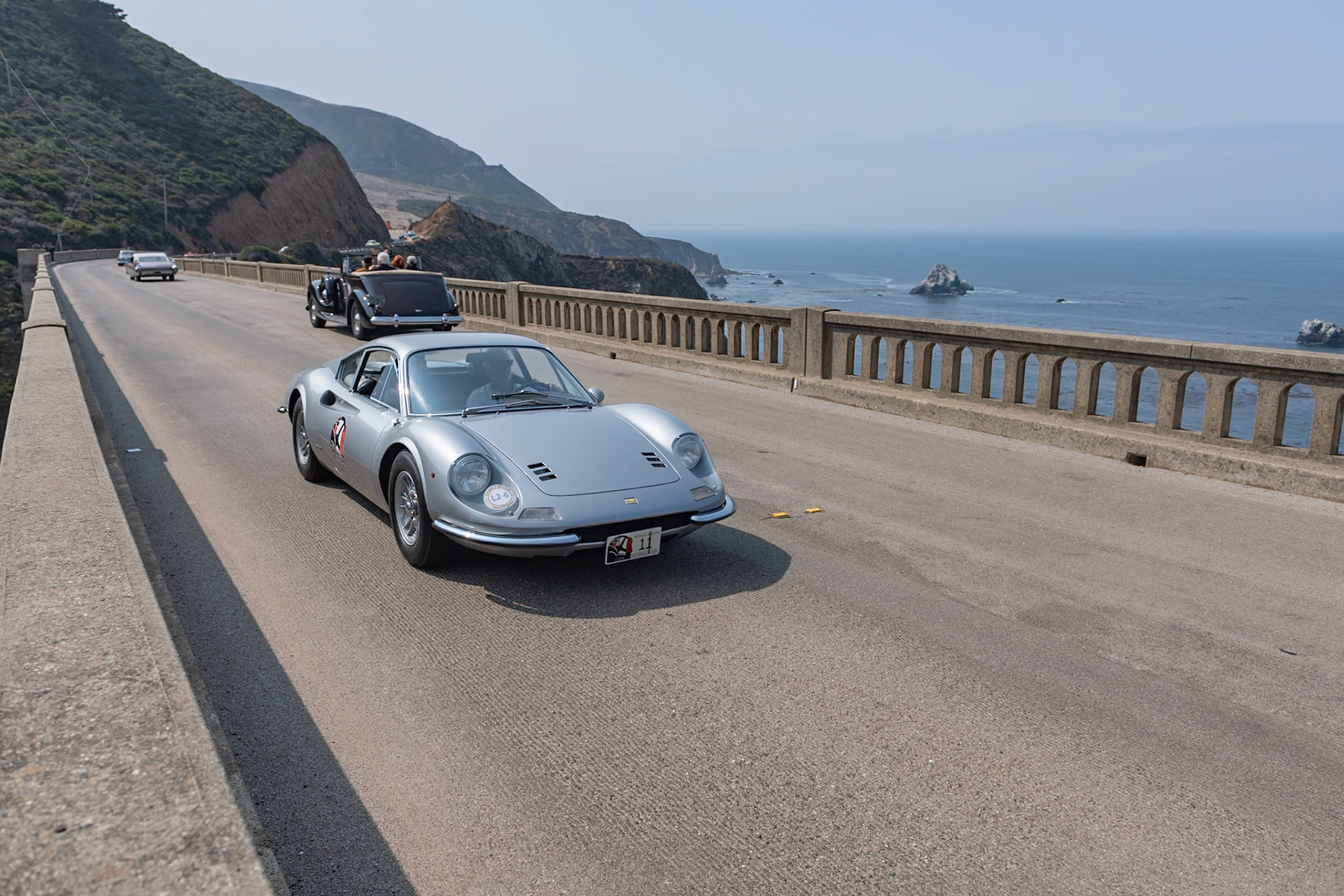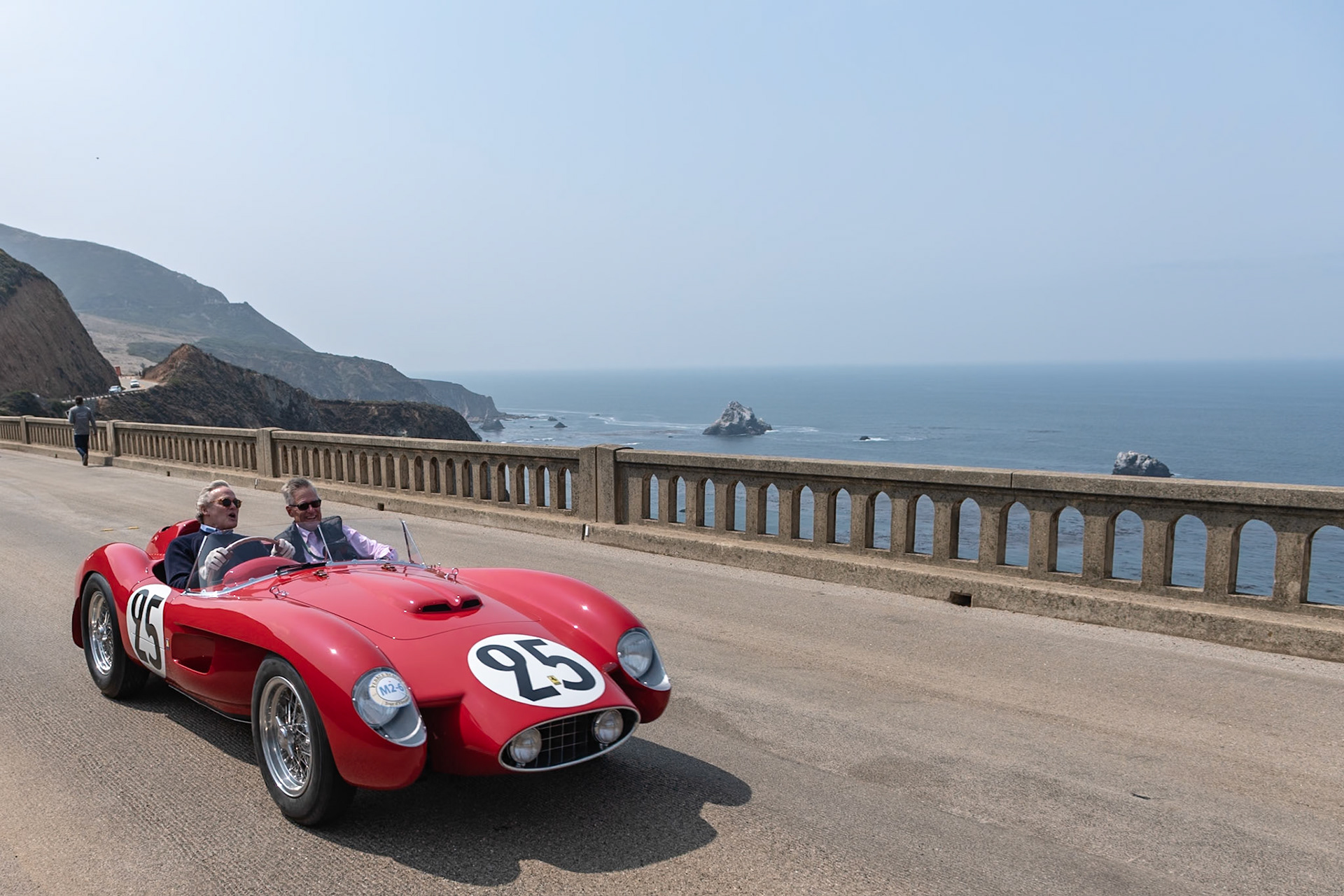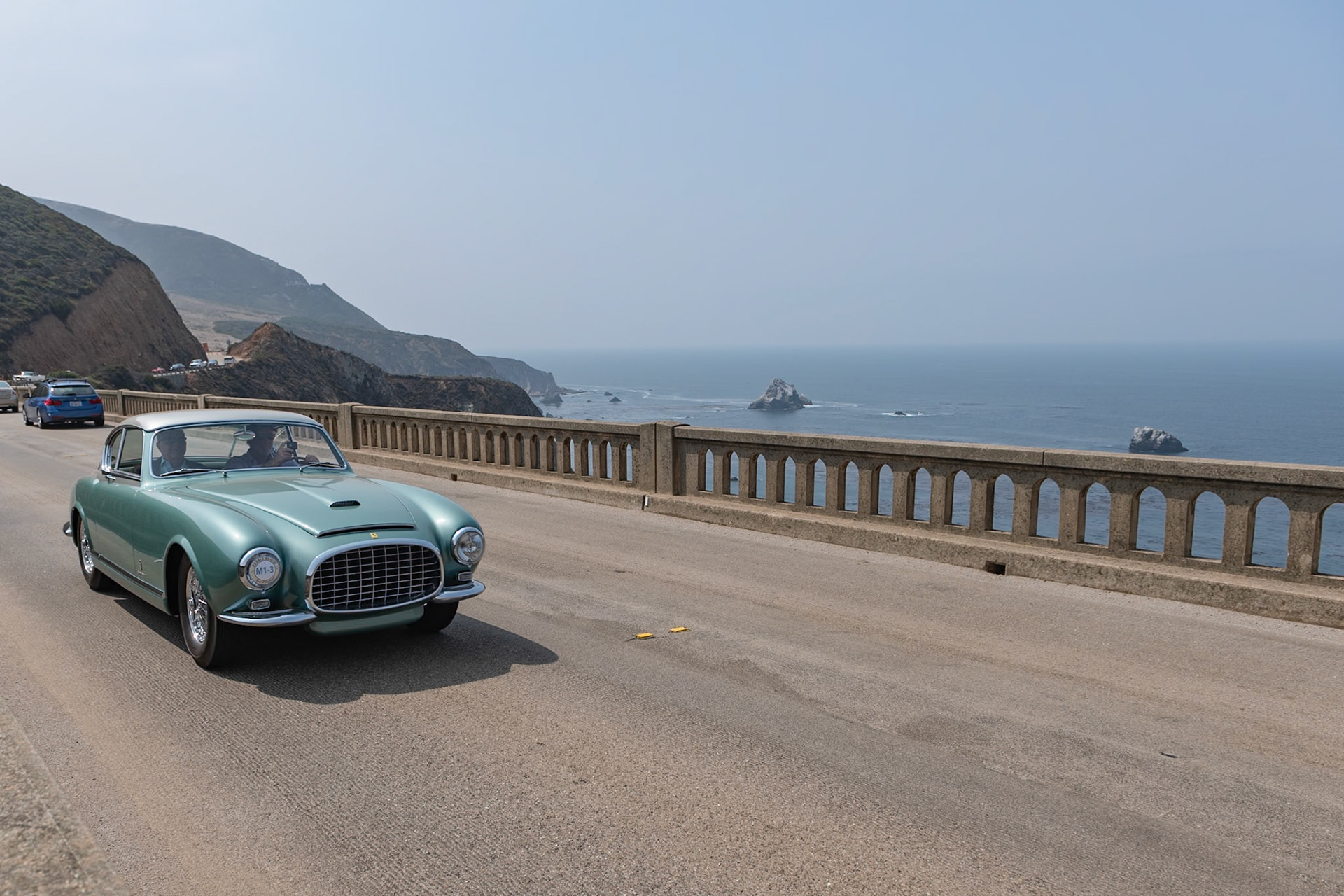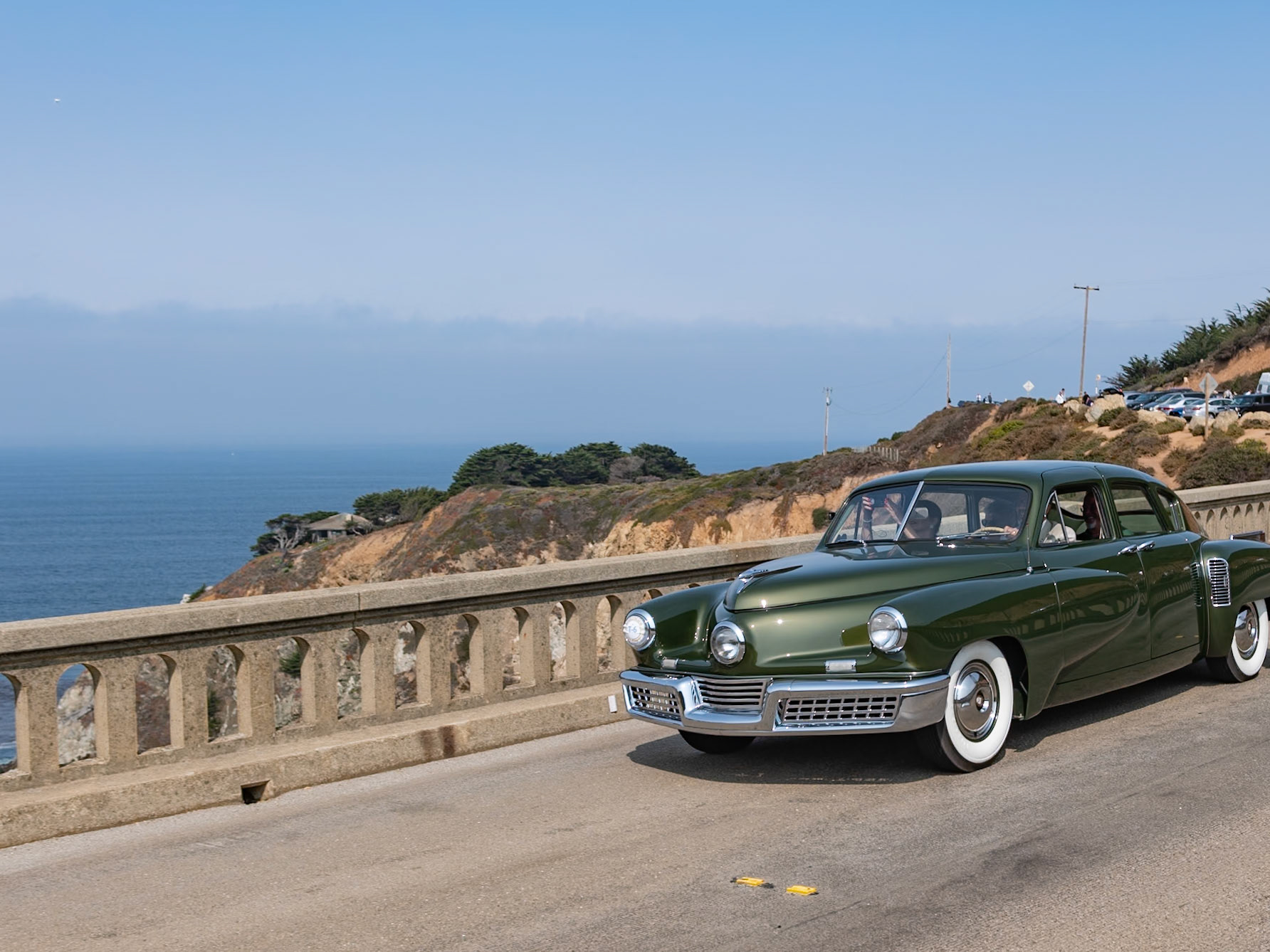
This Ferrari (chassis 0728) is one of the most famous of all Testa Rossas. It finished first overall at the 24 Hours of Le Mans in 1958 driven by Phil Hill and Olivier Gendebien, and it was third overall at that year’s Targa Florio driven by Mike Hawthorn and Wolfgang von Trips. It is an original left-hand drive Ferrari team car with outside door hinges and a fresh-air vent on the cowl (similar to 0666 TR). After the 1958 Targa Florio race, the car was converted at the Ferrari factory; the original pontoon fenders were removed for an envelope body. Several privateers later raced the car with a variety of different engines, as was normal at the time. It was sold eventually to Ferrari collector Pierre Bardinon in France, who reunited the car with its original engine. The current owner acquired the car in 2012.

This 166 MM (chassis 0026M), built with the larger 2.4-liter, V12 engine as designed for the Ferrari 195, was the first of five Le Mans Berlinettas built by Touring—and it had a very busy first few months! It was first shown at the Geneva Motor show in March of 1950. That April Giannino Marzotto drove it to Ferrari’s second consecutive win in the Mille Miglia. The following month Ferrari displayed the car on the Touring stand at the Turin Motor Show. And in June Marzotto drove the car to a first-place finish in the Notturne della Caracalla race in Rome, and then the car ran at Le Mans. Marzotto sold his Mille Miglia winner to an enthusiast in Switzerland in 1957, and about a decade later this significant racing car was abandoned. For a time it lay in pieces in a scrapyard alongside other Ferraris, including a 250 GT SWB and a 275 GTB. The current owner bought the dismantled car in 2003 and restored it in 2007.

Three Ferrari 335 Sport Spyders with V12, 4-liter engines were built in 1957—and then Luigi Chinetti persuaded Enzo Ferrari to build one more. This Spyder (chassis 0764) was completed by Scaglietti at the end of 1958. It was first presented at the New York Auto Show and was soon nicknamed the “Super Testa Rossa.” Alan Connell purchased the car and raced it at Road America, Watkins Glen, Daytona and Nassau in 1959 and 1960. Thereafter it was owned, driven and enjoyed by several different collectors, and in 1990 it was notably lent to Phil Hill to drive in the Mille Miglia Storica. The current owner acquired the Spyder in 2013.

Three Ferrari 335 Sport Spyders with V12, 4-liter engines were built in 1957—and then Luigi Chinetti persuaded Enzo Ferrari to build one more. This Spyder (chassis 0764) was completed by Scaglietti at the end of 1958. It was first presented at the New York Auto Show and was soon nicknamed the “Super Testa Rossa.” Alan Connell purchased the car and raced it at Road America, Watkins Glen, Daytona and Nassau in 1959 and 1960. Thereafter it was owned, driven and enjoyed by several different collectors, and in 1990 it was notably lent to Phil Hill to drive in the Mille Miglia Storica. The current owner acquired the Spyder in 2013.

David and Carol Seielstad Princeville, HI

David and Carol Seielstad Princeville, HI

This Superfast Coupe (chassis 0719SA), built on the 410 Superamerica chassis with a 4.9-liter engine, was created for the Dutch Ferrari collector and NART benefactor (and appropriately named) Jan de Vroom of New York City. De Vroom was an amateur racer who drove Ferraris at Sebring, Nassau, Palm Springs and Le Mans in 1957, along with George Arents, another of Luigi Chinetti’s NART financiers. This Ferrari was first displayed on the Pinin Farina stand at the 1957 Paris Auto Show and then the Turin Motor Show, and its sleek design later appeared on the cover of Sports Car Illustrated. The car was acquired by its current owner in 2003.

This Superfast Coupe (chassis 0719SA), built on the 410 Superamerica chassis with a 4.9-liter engine, was created for the Dutch Ferrari collector and NART benefactor (and appropriately named) Jan de Vroom of New York City. De Vroom was an amateur racer who drove Ferraris at Sebring, Nassau, Palm Springs and Le Mans in 1957, along with George Arents, another of Luigi Chinetti’s NART financiers. This Ferrari was first displayed on the Pinin Farina stand at the 1957 Paris Auto Show and then the Turin Motor Show, and its sleek design later appeared on the cover of Sports Car Illustrated. The car was acquired by its current owner in 2003.

This car (chassis 0102E) is one of seven 2.3-liter Ferrari 212 Export Barchettas bodied by Touring. Its first owner, Pietro Palmieri, raced it in the Giro della Calabria and the Coppa Adriatica, finishing first in class and a second and fourth overall. It was later loaned to and raced to a class win by Bobby Baird in the 1951 RAC’s famed Tourist Trophy race at Dundrod, Ireland. In 1954 Phil Hill brokered the car’s sale to 20th Century Fox and it starred in the 1955 movie The Racers in heavily modified form. In order to gain some background footage, the car was first filmed being driven by John Fitch at the 1954 Mille Miglia and later at Monaco before being sent to California for its starring role. In 1955 the car was sold to Al Crundall of Carmel, who showed it at the 1966 Pebble Beach Concours d’Elegance. A modified body was later built for the car. In early 2015, the original body, chassis and engine were reunited and the car was restored to its original configuration.

To replace the successful Ferrari P3, the factory developed the intermediate 412 P race car—also known as the P3/4. Designed by Mauro Forghieri, the 412 P features an aluminum body that owes its shape to the Ferrari wind tunnel, and the car develops 420 bhp due to its 4-liter, V12 engine with six Weber carburetors. This 412 P (chassis 0850) was purchased by the Ecurie Nationale Belge team of Jacques Swaters, and it raced in bright yellow livery at various events in 1967 and 1968. It finished second overall at the 1,000 km Race at Montlhéry in 1967 and it won the Cote de Condroz and Cote de la Roche Hill Climbs in 1968. The car was also entered in the 1967 24 Hours of Daytona when Ferraris famously finished 1-2-3. After its racing days concluded at the end of 1968, the 412 P was converted to street use for Dean Martin Jr. and was often seen on roads around Hollywood. It is shown here at Pebble Beach for the first time since being restored to its original racing specification.

In 1966 Ferrari launched the 275 GTB/C Berlinetta Competizione, which was built on a completely new chassis designed specifically for this model. The chassis, designated Tipo 590A by the factory, was lighter and stronger than the standard 275 chassis. This car (chassis 09067) is the ninth of twelve Ferrari 275 GTB/C Scaglietti Berlinetta Competizione cars built by the Ferrari factory that year. It retains all of its original components as well as the lightweight chassis and aluminum body panels. The car is presented in its original livery, with cast-aluminum wheels, FISPA air cleaner, and black leather and cloth seats that are rarely seen on Ferrari 275 GTB/C cars.

This berlinetta (chassis 3337) was the first of the steel-bodied cars built by Scaglietti in the final series. The car remained with Ferrari in Italy until it was purchased by Steve Earle, founder of the Monterey Historic Automobile Races, who kept it for 12 years. It then passed to Harley Cluxton. In the 1980s it was upgraded for racing and was driven by its next two owners, James Daugarty and William E. (Chip) Connor, who sold it to the present owner. In 2015, after the SWB was returned to its original road-going specification, it won the award for Best Restoration at the Cavallino Classic, the first of many concours successes.

This is the third of just three Ferraris with coachwork by Carrozzeria Boano. The Ferrari 410 Superamerica Boano Cabriolet (chassis 0485SA) was shown at the Turin Motor Show in 1956. It is identical in design to the first Ferrari body that Boano built on the 250 GT chassis and was initially sold, together with its twin, the 410 Superamerica Boano Coupe, to Giorgio Sisini Sorso, the Count of Sant’Andrea in Milan. It then passed to Roberto Crepaldi, who sold the car on behalf of the Sisini family to Bill Jacobs in Chicago, and in 1985 it was finally, and rightfully, paired alongside the Ferrari 410 Superamerica Boano Coupe that Robert M. Lee acquired in the same year. The complete Ferrari Boano Trio first appeared together at the Pebble Beach Concours d’Elegance in 1987, and the Concours is proud to display the trio now, thanks to the Robert M. Lee Collection and Anne Brockinton Lee, Bob’s wife and a great friend of the Concours.

The Ferrari 375 was introduced at the Paris Auto Salon in 1953, and just 45 were built before production ceased in May of 1955. The 375 chassis was fitted with Ferrari’s Aurelio Lampredi–designed 4.5-liter, V12 engine with three twin-choke Weber carburetors resulting in over 300 bhp. This rare example (chassis 0355AL), built for Fiat Chairman Gianni Agnelli, is one of eight coupes bodied by Pinin Farina from the total production run of just eleven Ferrari 375 Americas. Displayed at the 1955 Turin Motor Show, the car features a unique vertical grille and, at the rear, distinctive flying buttresses similar to those of the Ferrari 375 MM “Bergman Coupe” built a year earlier. It is also one of the few early Ferraris to have a sunroof. Its current owner bought the car in 2000 and it was restored in 2002. It placed First in Class at the 2003 Pebble Beach Concours d’Elegance.

The first Ferrari 500 Superfast was introduced in 1964 at the Geneva Motor Salon. Just 36 were produced over a period of two years—and all are accounted for today. When built, they were Ferrari’s fastest, most powerful and most exclusive road cars. Owners included the Shah of Iran, Prince Aga Khan, Prince Bernhard of the Netherlands and film star Peter Sellers. The 500 Superfast was aimed squarely at the British and American markets, with 10 cars going to England and 12 delivered to the United States. This car (chassis 8273SF) was among the 12 sent to the United States, where it has remained. Ferrari sent the chassis to Pininfarina in November 1965 and the car was completed in January 1966. It was specified with air conditioning and power windows but no power steering, and it was finished with ivory paintwork and black leather interior.

First shown at the 1954 Paris Auto Salon, this unique Ferrari 375 MM Berlinetta (chassis 0456AM) is fitted with a special body designed and constructed by Pinin Farina. Original carrozzeria records state that this car was used as the styling study for the 275 GTB built ten years later. Among its most striking features are the rotating headlights and the fins on the rear fenders. This car was ordered by film director Roberto Rossellini for his wife, Swedish actress Ingrid Bergman, and even though she never took delivery of the car, it is still referred to as the “Bergman Coupe.” Rossellini owned the car between 1954 and 1957, and then it went to the United States. This famous Ferrari has been with its current owner for 39 years. It recently participated in the 1,500-mile Pebble Beach Motoring Classic.

This 166 MM (chassis 0026M), built with the larger 2.4-liter, V12 engine as designed for the Ferrari 195, was the first of five Le Mans Berlinettas built by Touring—and it had a very busy first few months! It was first shown at the Geneva Motor show in March of 1950. That April Giannino Marzotto drove it to Ferrari’s second consecutive win in the Mille Miglia. The following month Ferrari displayed the car on the Touring stand at the Turin Motor Show. And in June Marzotto drove the car to a first-place finish in the Notturne della Caracalla race in Rome, and then the car ran at Le Mans. Marzotto sold his Mille Miglia winner to an enthusiast in Switzerland in 1957, and about a decade later this significant racing car was abandoned. For a time it lay in pieces in a scrapyard alongside other Ferraris, including a 250 GT SWB and a 275 GTB. The current owner bought the dismantled car in 2003 and restored it in 2007.

This Ferrari (chassis 0728) is one of the most famous of all Testa Rossas. It finished first overall at the 24 Hours of Le Mans in 1958 driven by Phil Hill and Olivier Gendebien, and it was third overall at that year’s Targa Florio driven by Mike Hawthorn and Wolfgang von Trips. It is an original left-hand drive Ferrari team car with outside door hinges and a fresh-air vent on the cowl (similar to 0666 TR). After the 1958 Targa Florio race, the car was converted at the Ferrari factory; the original pontoon fenders were removed for an envelope body. Several privateers later raced the car with a variety of different engines, as was normal at the time. It was sold eventually to Ferrari collector Pierre Bardinon in France, who reunited the car with its original engine. The current owner acquired the car in 2012.

Three Ferrari 335 Sport Spyders with V12, 4-liter engines were built in 1957—and then Luigi Chinetti persuaded Enzo Ferrari to build one more. This Spyder (chassis 0764) was completed by Scaglietti at the end of 1958. It was first presented at the New York Auto Show and was soon nicknamed the “Super Testa Rossa.” Alan Connell purchased the car and raced it at Road America, Watkins Glen, Daytona and Nassau in 1959 and 1960. Thereafter it was owned, driven and enjoyed by several different collectors, and in 1990 it was notably lent to Phil Hill to drive in the Mille Miglia Storica. The current owner acquired the Spyder in 2013.

David and Carol Seielstad Princeville, HI

This Superfast Coupe (chassis 0719SA), built on the 410 Superamerica chassis with a 4.9-liter engine, was created for the Dutch Ferrari collector and NART benefactor (and appropriately named) Jan de Vroom of New York City. De Vroom was an amateur racer who drove Ferraris at Sebring, Nassau, Palm Springs and Le Mans in 1957, along with George Arents, another of Luigi Chinetti’s NART financiers. This Ferrari was first displayed on the Pinin Farina stand at the 1957 Paris Auto Show and then the Turin Motor Show, and its sleek design later appeared on the cover of Sports Car Illustrated. The car was acquired by its current owner in 2003.

This car (chassis 0102E) is one of seven 2.3-liter Ferrari 212 Export Barchettas bodied by Touring. Its first owner, Pietro Palmieri, raced it in the Giro della Calabria and the Coppa Adriatica, finishing first in class and a second and fourth overall. It was later loaned to and raced to a class win by Bobby Baird in the 1951 RAC’s famed Tourist Trophy race at Dundrod, Ireland. In 1954 Phil Hill brokered the car’s sale to 20th Century Fox and it starred in the 1955 movie The Racers in heavily modified form. In order to gain some background footage, the car was first filmed being driven by John Fitch at the 1954 Mille Miglia and later at Monaco before being sent to California for its starring role. In 1955 the car was sold to Al Crundall of Carmel, who showed it at the 1966 Pebble Beach Concours d’Elegance. A modified body was later built for the car. In early 2015, the original body, chassis and engine were reunited and the car was restored to its original configuration.

To replace the successful Ferrari P3, the factory developed the intermediate 412 P race car—also known as the P3/4. Designed by Mauro Forghieri, the 412 P features an aluminum body that owes its shape to the Ferrari wind tunnel, and the car develops 420 bhp due to its 4-liter, V12 engine with six Weber carburetors. This 412 P (chassis 0850) was purchased by the Ecurie Nationale Belge team of Jacques Swaters, and it raced in bright yellow livery at various events in 1967 and 1968. It finished second overall at the 1,000 km Race at Montlhéry in 1967 and it won the Cote de Condroz and Cote de la Roche Hill Climbs in 1968. The car was also entered in the 1967 24 Hours of Daytona when Ferraris famously finished 1-2-3. After its racing days concluded at the end of 1968, the 412 P was converted to street use for Dean Martin Jr. and was often seen on roads around Hollywood. It is shown here at Pebble Beach for the first time since being restored to its original racing specification.

The Ferrari 250 GT SWB Berlinetta was one of the last Ferraris designed as both a grand touring car and a race car. A total of 165 of these berlinettas were built between 1959 and 1963, seventy with aluminum coachwork and the rest in steel. This example (chassis 2243GT) was the first of ten steel-bodied cars built as homologation cars on the competition frame. It was also the first 250 GT SWB with the window vents that were included on all the later cars. This important Ferrari has been cared for by eleven owners during its lifetime, including John Lundin, a founder of the Ferrari Club of America. The current owner has returned the berlinetta to the condition it was in when first delivered to Luigi Chinetti.

This berlinetta (chassis 3337) was the first of the steel-bodied cars built by Scaglietti in the final series. The car remained with Ferrari in Italy until it was purchased by Steve Earle, founder of the Monterey Historic Automobile Races, who kept it for 12 years. It then passed to Harley Cluxton. In the 1980s it was upgraded for racing and was driven by its next two owners, James Daugarty and William E. (Chip) Connor, who sold it to the present owner. In 2015, after the SWB was returned to its original road-going specification, it won the award for Best Restoration at the Cavallino Classic, the first of many concours successes.

The Ferrari 375 was introduced at the Paris Auto Salon in 1953, and just 45 were built before production ceased in May of 1955. The 375 chassis was fitted with Ferrari’s Aurelio Lampredi–designed 4.5-liter, V12 engine with three twin-choke Weber carburetors resulting in over 300 bhp. This rare example (chassis 0355AL), built for Fiat Chairman Gianni Agnelli, is one of eight coupes bodied by Pinin Farina from the total production run of just eleven Ferrari 375 Americas. Displayed at the 1955 Turin Motor Show, the car features a unique vertical grille and, at the rear, distinctive flying buttresses similar to those of the Ferrari 375 MM “Bergman Coupe” built a year earlier. It is also one of the few early Ferraris to have a sunroof. Its current owner bought the car in 2000 and it was restored in 2002. It placed First in Class at the 2003 Pebble Beach Concours d’Elegance.

Following the introduction of the Ferrari 275 GTB/4, Ferrari’s New York distributor and founder of the North America Racing Team Luigi Chinetti convinced Enzo Ferrari to build a convertible for the American market. The new 275 GTB/4S (or GTS/4) NART with Scaglietti Spyder body soon appeared with Steve McQueen and Faye Dunaway in the film The Thomas Crown Affair and a small number were quite quickly sold. A few more found owners after a NART Spyder was raced at the 12 Hours of Sebring driven by Marianne “Pinky” Rollo and Denise McCluggage in 1967. Despite being front-page news just ten examples were built, and this car (chassis 11057) is the last of the ten. Known as the “European NART Spyder,” it was first delivered to a Spanish Colonel of the Foreign Legion, then was sold to Jose Segimon in Madrid. It was sold again in 1982, and it has since been owned and enjoyed by several notable Ferrari collectors in Europe and America.

First shown at the 1954 Paris Auto Salon, this unique Ferrari 375 MM Berlinetta (chassis 0456AM) is fitted with a special body designed and constructed by Pinin Farina. Original carrozzeria records state that this car was used as the styling study for the 275 GTB built ten years later. Among its most striking features are the rotating headlights and the fins on the rear fenders. This car was ordered by film director Roberto Rossellini for his wife, Swedish actress Ingrid Bergman, and even though she never took delivery of the car, it is still referred to as the “Bergman Coupe.” Rossellini owned the car between 1954 and 1957, and then it went to the United States. This famous Ferrari has been with its current owner for 39 years. It recently participated in the 1,500-mile Pebble Beach Motoring Classic.

This unique prototype coupe followed the 206 Dino racing cars that ran at Le Mans powered by Ferrari’s 2-liter, V6 Dino engine. First seen at a 1966 Ferrari press conference, the 206 Dino was bodied by Piero Drogo and featured light alloy bodywork and a semi-monocoque chassis. Only 18 were built, including 12 coupes that ran in the Group 6 prototype class. This 206 Dino S (chassis 10523) was built by Ferrari before going to Pininfarina to receive this custom coupe body designed by Paolo Martin. The finished car, with Ferrari’s first and only gullwing doors, was shown at the 1967 Frankfurt Auto Show as a Dino Berlinetta Competizione and received much acclaim. Regrettably, the car never went into production; it remained in the Pininfarina museum until 2006.

In 1961 Ferrari launched the ultimate 250 GT SWB, often referred to as a SEFAC Hot Rod but also known more formally as the Comp/61. A few of the 250 SWB Competiziones also received a mechanical makeover for the 1961 season. At the time there was little competition that could rival the SWB in the GT class, and it often beat the Jaguar E-type and Aston Martin DB4 in sports car races. This car (2689GT) is one of the most famous of the 20 alloy-bodied SWBs. It was driven to third overall and first in class at the 1961 24 Hours of LeMans by Pierre Noblet and Jean Guichet. They continued to race the car and racked up what is probably the most desirable of race records among all the SWBs.

Marty and Molly Ann Moore, Cherry Hills Village, CO

This 1953 Ferrari 166 MM first carried a Vignale coupe body when delivered to its first owner, Jaques Herzet. After racing in the Coupe de Spa-Francorchamps, the Rallye des Alpes, the Liege-Rome-Liege, and the Tour de France, the car placed second in the 1953 European Championship. Herzet then took the car to South America for another series of races. After returning to Europe, the car was sent to Carrozzeria Oblin in Brussels to be re-bodied as the spyder it is today. With its new look, this 166 MM (chassis 0300M) soon raced again; at the 1954 Twelve Hours of Reims, Herzet shared the drive with Johnny Claes. The car’s racing days continued until 1957 when Herzet hung up his goggles for the last time. The car has recently changed hands and has been restored to the condition it was in at the end of the 1954 season, with matte-black paintwork and a glossy red racing stripe.

This Ferrari (chassis 0774 TR) was the fifth and final 250 TR59 constructed in 1959. It made its debut at the 24 Hours of Le Mans driven by Jean Behra and Dan Gurney, and it also ran in the Tourist Trophy at Goodwood driven by Phil Hill. After being updated in 1960 to new TR59/60 specifications, it won in its first time out at the Buenos Aires 1,000 km driven by Phil Hill and Cliff Allison. That June, Olivier Gendebien and Paul Frère drove the car to victory in the 24 Hours of Le Mans. It then moved to the United States where it was briefly raced again by Phil Hill. Following its own racing career, the car’s V12 engine was used for a time in another racing car. But car and engine were reunited in the 1980s, when owned by Paul Pappalardo, and the car was restored to its 1960 Le Mans–winning specifications. It was then raced throughout the 1990s. The current owner bought the car in 2004 and showed it at Pebble Beach in 2009 along with the other three surviving TR59/60s.

This Ferrari (chassis 0774 TR) was the fifth and final 250 TR59 constructed in 1959. It made its debut at the 24 Hours of Le Mans driven by Jean Behra and Dan Gurney, and it also ran in the Tourist Trophy at Goodwood driven by Phil Hill. After being updated in 1960 to new TR59/60 specifications, it won in its first time out at the Buenos Aires 1,000 km driven by Phil Hill and Cliff Allison. That June, Olivier Gendebien and Paul Frère drove the car to victory in the 24 Hours of Le Mans. It then moved to the United States where it was briefly raced again by Phil Hill. Following its own racing career, the car’s V12 engine was used for a time in another racing car. But car and engine were reunited in the 1980s, when owned by Paul Pappalardo, and the car was restored to its 1960 Le Mans–winning specifications. It was then raced throughout the 1990s. The current owner bought the car in 2004 and showed it at Pebble Beach in 2009 along with the other three surviving TR59/60s.

In 1961 Ferrari launched the ultimate 250 GT SWB, often referred to as a SEFAC Hot Rod but also known more formally as the Comp/61. A few of the 250 SWB Competiziones also received a mechanical makeover for the 1961 season. At the time there was little competition that could rival the SWB in the GT class, and it often beat the Jaguar E-type and Aston Martin DB4 in sports car races. This car (2689GT) is one of the most famous of the 20 alloy-bodied SWBs. It was driven to third overall and first in class at the 1961 24 Hours of LeMans by Pierre Noblet and Jean Guichet. They continued to race the car and racked up what is probably the most desirable of race records among all the SWBs.

This Ferrari 250 GT LWB Scaglietti Berlinetta (chassis 1321 GT) was the highest placed Ferrari at the 24 Hours of Le Mans in 1959. It was entered by the Belgian national team Ecurie Francorchamps and was driven by Léon Dernier and Jean Blaton—and it won the three-liter GT class and finished third overall. After a few years in Europe, the car was taken to the United States in 1968, and there it was purchased by Manfred Lampe. Its current owner acquired the car in 2011 and has shown it at several Ferrari events. It still wears the distinctive livery it wore at Le Mans.

This unique prototype coupe followed the 206 Dino racing cars that ran at Le Mans powered by Ferrari’s 2-liter, V6 Dino engine. First seen at a 1966 Ferrari press conference, the 206 Dino was bodied by Piero Drogo and featured light alloy bodywork and a semi-monocoque chassis. Only 18 were built, including 12 coupes that ran in the Group 6 prototype class. This 206 Dino S (chassis 10523) was built by Ferrari before going to Pininfarina to receive this custom coupe body designed by Paolo Martin. The finished car, with Ferrari’s first and only gullwing doors, was shown at the 1967 Frankfurt Auto Show as a Dino Berlinetta Competizione and received much acclaim. Regrettably, the car never went into production; it remained in the Pininfarina museum until 2006.

Marty and Molly Ann Moore, Cherry Hills Village, CO

This 1953 Ferrari 166 MM first carried a Vignale coupe body when delivered to its first owner, Jaques Herzet. After racing in the Coupe de Spa-Francorchamps, the Rallye des Alpes, the Liege-Rome-Liege, and the Tour de France, the car placed second in the 1953 European Championship. Herzet then took the car to South America for another series of races. After returning to Europe, the car was sent to Carrozzeria Oblin in Brussels to be re-bodied as the spyder it is today. With its new look, this 166 MM (chassis 0300M) soon raced again; at the 1954 Twelve Hours of Reims, Herzet shared the drive with Johnny Claes. The car’s racing days continued until 1957 when Herzet hung up his goggles for the last time. The car has recently changed hands and has been restored to the condition it was in at the end of the 1954 season, with matte-black paintwork and a glossy red racing stripe.

The prototype Dino 206 S was built in 1965 to be a contender for the 1966 2-liter sports car class. The engine was based on the earlier 1.6-liter Ferrari 166 P, enlarged to 2-liters and fitted with 3 Weber carburetors, which were replaced on later cars by Lucas fuel injection. Initially, Ferrari planned to produce 50 cars for homologation purposes, but industrial unrest in Italy halted the car’s production and only 18 were ever completed. Piero Drogo designed the body, and the cars were all built by his company, Carrozzeria Sports Cars. This Dino 206 S (chassis 028) is one of the last built. Its first owner, Eduardo Lualdi-Gabardi, a Ferrari customer since 1953, raced the car in the European Hill Climb championship and at the 1000-km race at Monza. After 1971, the car changed hands several times before being acquired by its current owner in 2014.

The Ferrari 250 Testa Rossa, developed in early 1957, had a new 3.0-liter V12 engine designed by Gioacchino Colombo installed in a chassis based on the earlier Ferrari 500 TRC. The first prototype made its racing debut in the 1,000 Kilometres at the Nürburgring, and the Testa Rossas that followed helped to secure Ferrari’s important place in sports car history. In July 1958, this Ferrari 250 TR (chassis 0756 TR) was shipped from the Ferrari factory to John Von Neumann’s dealership in California for its first owner, Dick Morgensen of Phoenix, Arizona. From the end of 1958 through the 1960 season, Morgensen campaigned the car all over California and Arizona with considerable success. Later, during the 1970s and ’80s, the car enjoyed similar success in the hands of historic racer Lou Sellyei. The car was purchased by its current owner in 2008 and has just returned from Italy following a complete restoration preserving all of the original components.

The Ferrari 250 Testa Rossa, developed in early 1957, had a new 3.0-liter V12 engine designed by Gioacchino Colombo installed in a chassis based on the earlier Ferrari 500 TRC. The first prototype made its racing debut in the 1,000 Kilometres at the Nürburgring, and the Testa Rossas that followed helped to secure Ferrari’s important place in sports car history. In July 1958, this Ferrari 250 TR (chassis 0756 TR) was shipped from the Ferrari factory to John Von Neumann’s dealership in California for its first owner, Dick Morgensen of Phoenix, Arizona. From the end of 1958 through the 1960 season, Morgensen campaigned the car all over California and Arizona with considerable success. Later, during the 1970s and ’80s, the car enjoyed similar success in the hands of historic racer Lou Sellyei. The car was purchased by its current owner in 2008 and has just returned from Italy following a complete restoration preserving all of the original components.

First seen at the Paris Auto Salon in 1962, the 3-liter V12-engined Ferrari 250 GT Lusso was the only Ferrari model from the 1960s identified by a single word: “Lusso.” Designed by Pininfarina with bodywork sculpted in the workshop of Sergio Scaglietti, the Lusso was the final Ferrari model to use the venerable 250-series engine. The Lusso bridged the gap between the sporting Ferrari 250 GT SWB and the more luxurious Ferrari 250 GTE 2+2, and between January 1963 and August 1964, a total of 350 examples were sold. Imported via Luigi Chinetti, this Lusso (chassis 5607) was first delivered to Rezzaghi Motors of San Francisco. It was owned later and enjoyed for 27 years and 70,000 miles by a family in Oakland, California. The car passed among several Ferrari fans, including one in Japan, before returning to California in 2007. More recently this Lusso has won several awards, including First in Class at the Ferrari 70th Anniversary Concours in Maranello, Italy.

In October 1952 the first Ferrari 250 MM was displayed at the Paris Auto Salon. It was derived from the one-off Ferrari 250 S, which had won the Mille Miglia earlier that year. This 250 MM (0260MM) is one of two First Series Spyders built by Vignale, and the only one still with its original coachwork. It was delivered to its first owner, Phil Hill, in March 1953, and then was shown by Luigi Chinetti at the New York International Motor Sport Show in April. Later the same month, Hill entered the Ferrari in the Del Monte Trophy race at Pebble Beach, where he finished in first place. He continued to compete with the car, achieving additional victories during the 1953 season. In the hands of later owners, the car continued to be raced until the end of 1957. For the last 60 years, the car has been cared for by a series of collectors in the United States. The current owner has restored it to its original specification.

The Ferrari 410 Sport CM was developed from the Le Mans–winning Ferrari 375 Plus primarily for the Carrera Panamericana (the CM stands for Carrera Messicana), but also with an eye toward the growing importance of the North American racing scene. The new Aurelio Lampredi–designed, 5.0-liter V12 engine was the most powerful yet to leave the Ferrari factory. This 410 Sport CM (Chassis 0592 CM) is one of three 410 Spyders built by Scaglietti. It was sold initially to American team owner, Tony Parravano, and it first raced at Palm Springs where, driven by Carroll Shelby, it finished in first place. In 1957, Parravano headed to Mexico with a number of his race cars, not to compete in the Carrera Panamericana but because he was being chased by the IRS for tax “complications.” After crossing the border he was never seen again—although his cars turned up three years later! In 1970, this car was acquired by Robert Dusek, who restored it to the way it was when last raced by Scuderia Parravano.

Ferrari introduced the 212 Inter at the Paris Auto Salon in October 1951, and around 80 examples were produced, almost all of them closed coupes. Powered by a 2.5-liter V12 engine fed by a single Weber carburettor, the 212 Inter was soon seen in competition. One of its first wins was at the 1952 Carrera Panamericana when a pair of 212 Vignale-built coupes finished the grueling road race in first and second place. Carrozzeria Vignale built most of the closed 212 coupes as well as several cabriolets, although other examples were built by Ghia, Pinin Farina, and Touring. This car (chassis 0175E) was delivered to its first owner via Ferrari dealer Franco Cornacchia of the Scuderia Guastalla racing team. After a succession of owners in Italy, the car went to the United States in the mid-1950s. Its list of American owners includes Jack Christianson, Warren Scott, who removed the original motor and sold it, and Jack Stewart, who reunited that engine with the car in the 1970s. This Ferrari 212 Inter was acquired by the Audrain Auto Museum in 2017.

The Ferrari 250 MM was built primarily to compete in long distance road races such as the Mille Miglia and the Carrera Panamericana as well as in endurance circuit races like the 24 Hours of Le Mans. This 250 MM is one of eighteen Coupes designed and built by Pinin Farina on Ferrari’s 94-inch wheelbase with the 2.9-liter, 240-bhp, Colombo-designed V12 engine. This Ferrari (Chassis 0258 MM) was raced in the 1953 Mille Miglia by Count Bruno Sterzi and Giulio Rovelli. After its racing days in Italy, the car was delivered to Luigi Chinetti in New York and then driven by George Arents in several North American sports car races. The current owner has had this Ferrari restored for its debut at Pebble Beach.

Two years after the first Spyder California was announced in 1958, Ferrari introduced an improved Spyder California, built on an 8-inch-shorter competition chassis from the Ferrari 250 GT SWB race car. Its V12 engine was uprated to the semi-competition Tipo 168 specification and, to cope with the increase in power, it was fitted with Dunlop disc brakes. Between 1960 and 1963, a total of 56 SWB Spyder California’s were built. The Pininfarina styling was almost identical to the earlier LWB model, the most obvious change being the air intake. Most SWBs also had covered headlights. The early history of this steel bodied car (chassis 3293GT) is not known, but in the mid-1960s it was driven for a short time by the comedian, film star and former guest host at the Pebble Beach Concours Bob Hope while he was touring in Europe for the United Service Organization. In 1975 the car was imported to the United States by racer and sports car collector Harley Cluxton. After it crisscrossed the Atlantic between additional owners, it landed in New Jersey with its current owner in 2007.

This Ferrari 342 America (chassis 0232AL) was the first of three cabriolets powered by a Lampredi-designed 4-liter, V12 engine, and it is the only 342 America bodied by Carrozeria Vignale. In total six Ferrari 342 Americas were built, and all were given an even chassis number, normally reserved for Ferrari competition cars. All the numbers ended in AL for the longer “America Lungo” chassis. The body was designed by Giovanni Michelotti, and although it shares many elements with other Vignale-built cars of the era, this car has several unique features, including the slotted taillights that are recessed into the fenders. After driving a 340 America in the 1951 Mille Miglia, amateur Swiss racer Otto Wild, a close friend of Enzo Ferrari, ordered this 342 America. The car was imported to the United States in the late 1950s and remained with the same owner in California for 34 years but was rarely seen in public. Having just been restored to its original specification by its current owner, this is the first time the car has been to Pebble Beach.

The Ferrari 500 Mondial used a new 4-cylinder engine developed by Ferrari’s chief engineer, Aurelio Lampredi. The 4-cylinder layout had better low-end torque than Ferrari’s V12, allowing for more acceleration out of corners, and its lighter weight provided better handling. At its first race, the 12 Hours of Casablanca in December 1953, factory drivers Alberto Ascari and Gigi Villoresi finished first in class and second overall, and the model went on to play an integral role in winning Ferrari’s second Sports Car World Championship in 1954. This car (chassis 0580MD) is a second series Mondial built by Sergio Scaglietti. First shown in Stockholm, Sweden, in 1956, it was raced throughout Scandinavia, often on ice-circuits wearing spiked tires, until 1960. Once its ice-racing career was over, it was sold to Claudio Caggiati in Italy who entered the car in a record-breaking 17 Mille Miglia retrospectives. Its present owner bought the car at the end of 2014 and has now restored it to its Stockholm Auto Show condition.

The Ferrari 500 Mondial used a new 4-cylinder engine developed by Ferrari’s chief engineer, Aurelio Lampredi. The 4-cylinder layout had better low-end torque than Ferrari’s V12, allowing for more acceleration out of corners, and its lighter weight provided better handling. At its first race, the 12 Hours of Casablanca in December 1953, factory drivers Alberto Ascari and Gigi Villoresi finished first in class and second overall, and the model went on to play an integral role in winning Ferrari’s second Sports Car World Championship in 1954. This car (chassis 0580MD) is a second series Mondial built by Sergio Scaglietti. First shown in Stockholm, Sweden, in 1956, it was raced throughout Scandinavia, often on ice-circuits wearing spiked tires, until 1960. Once its ice-racing career was over, it was sold to Claudio Caggiati in Italy who entered the car in a record-breaking 17 Mille Miglia retrospectives. Its present owner bought the car at the end of 2014 and has now restored it to its Stockholm Auto Show condition.

The Ferrari 400 Superamerica was one of the most exclusive road-going cars of its era. It debuted at the 1959 Turin Motor Show and a total of 25 cars were built between 1959 and 1962. It was Ferrari’s first road car where the model designation number referred to the total engine capacity of 4-liters. Several body styles by Pininfarina and Scaglietti were offered, all built on Ferrari’s short 95-inch wheelbase. This Superamerica (chassis 1885SA) is a Series 1 Cabriolet ordered with a factory hardtop and open headlights for its first owner, who lived in Milan. The car also spent a short period in Australia, then was brought to the United States in 1987. It was acquired by its current owner in 2006.

The Ferrari 400 Superamerica was one of the most exclusive road-going cars of its era. It debuted at the 1959 Turin Motor Show and a total of 25 cars were built between 1959 and 1962. It was Ferrari’s first road car where the model designation number referred to the total engine capacity of 4-liters. Several body styles by Pininfarina and Scaglietti were offered, all built on Ferrari’s short 95-inch wheelbase. This Superamerica (chassis 1885SA) is a Series 1 Cabriolet ordered with a factory hardtop and open headlights for its first owner, who lived in Milan. The car also spent a short period in Australia, then was brought to the United States in 1987. It was acquired by its current owner in 2006.

For the 1956 season, Ferrari developed a new 2-liter engine to outpace its main rival, the Maserati 200 S. Designed by Ferrari’s new chief engineer, Vittorio Jano, the new 4-cylinder engine used Aurelio Lampredi’s Mondial 500 as a starting point. The new engine was given bright red cylinder heads, and the name Testa Rossa was born. Scaglietti created the body for the 500 TR, and the new car first raced in the 1956 Monza Supercortemaggiore where Peter Collins and Mike Hawthorn secured victory. This Testa Rossa (chassis 0600MD TR), is that first Testa Rossa, which was delivered to the Ecurie Francorchamps team. It raced throughout Europe in 1956 then was sold back to the factory. After three lesser races with Francois Picard, Ferrari sent the car to Luigi Chinetti to be raced at Nassau in 1958, but it was crashed by Pedro Rodriguez and returned to Scaglietti to be rebodied with pontoon-fenders. Rodriguez raced the rebodied car at Le Mans, then it was sold to Jim Hunt and Lucky Casner, who raced it successfully in the United States in 1959, its last competitive year.

For the 1956 season, Ferrari developed a new 2-liter engine to outpace its main rival, the Maserati 200 S. Designed by Ferrari’s new chief engineer, Vittorio Jano, the new 4-cylinder engine used Aurelio Lampredi’s Mondial 500 as a starting point. The new engine was given bright red cylinder heads, and the name Testa Rossa was born. Scaglietti created the body for the 500 TR, and the new car first raced in the 1956 Monza Supercortemaggiore where Peter Collins and Mike Hawthorn secured victory. This Testa Rossa (chassis 0600MD TR), is that first Testa Rossa, which was delivered to the Ecurie Francorchamps team. It raced throughout Europe in 1956 then was sold back to the factory. After three lesser races with Francois Picard, Ferrari sent the car to Luigi Chinetti to be raced at Nassau in 1958, but it was crashed by Pedro Rodriguez and returned to Scaglietti to be rebodied with pontoon-fenders. Rodriguez raced the rebodied car at Le Mans, then it was sold to Jim Hunt and Lucky Casner, who raced it successfully in the United States in 1959, its last competitive year.

For the 1956 season, Ferrari developed a new 2-liter engine to outpace its main rival, the Maserati 200 S. Designed by Ferrari’s new chief engineer, Vittorio Jano, the new 4-cylinder engine used Aurelio Lampredi’s Mondial 500 as a starting point. The new engine was given bright red cylinder heads, and the name Testa Rossa was born. Scaglietti created the body for the 500 TR, and the new car first raced in the 1956 Monza Supercortemaggiore where Peter Collins and Mike Hawthorn secured victory. This Testa Rossa (chassis 0600MD TR), is that first Testa Rossa, which was delivered to the Ecurie Francorchamps team. It raced throughout Europe in 1956 then was sold back to the factory. After three lesser races with Francois Picard, Ferrari sent the car to Luigi Chinetti to be raced at Nassau in 1958, but it was crashed by Pedro Rodriguez and returned to Scaglietti to be rebodied with pontoon-fenders. Rodriguez raced the rebodied car at Le Mans, then it was sold to Jim Hunt and Lucky Casner, who raced it successfully in the United States in 1959, its last competitive year.

The Ferrari 342 America was one of Ferrari’s most exclusive production series; each car was finished to a customer’s specific order. Just six examples were built in total, three coupes and two cabriolets by Pinin Farina, and one cabriolet by Vignale. The first two 342 Americas were ordered by King Leopold of Belgium and another was owned by Enzo Ferrari himself. This car (chassis 0246AL), the last coupe built, was shown at the 1953 Geneva Motor Show before being delivered to its first owner, Ernesto Fassio, a wealthy shipping magnate from Genoa. According to the factory it was fitted with a larger fuel tank, a rally timer, which is still in the car, and an uprated 230-bhp engine to compete in the 1953 Rallye du Soleil in Cannes as well as later rallies in Italy and France. The car left Europe in 1954 and was shown at its first concours at Wilmot Hills, Wisconsin, by Steve Briggs of Lake Forest, Illinois. After several other owners, the car was purchased in 2013 by its current owner, who restored it.

The Ferrari 342 America was one of Ferrari’s most exclusive production series; each car was finished to a customer’s specific order. Just six examples were built in total, three coupes and two cabriolets by Pinin Farina, and one cabriolet by Vignale. The first two 342 Americas were ordered by King Leopold of Belgium and another was owned by Enzo Ferrari himself. This car (chassis 0246AL), the last coupe built, was shown at the 1953 Geneva Motor Show before being delivered to its first owner, Ernesto Fassio, a wealthy shipping magnate from Genoa. According to the factory it was fitted with a larger fuel tank, a rally timer, which is still in the car, and an uprated 230-bhp engine to compete in the 1953 Rallye du Soleil in Cannes as well as later rallies in Italy and France. The car left Europe in 1954 and was shown at its first concours at Wilmot Hills, Wisconsin, by Steve Briggs of Lake Forest, Illinois. After several other owners, the car was purchased in 2013 by its current owner, who restored it.

The Ferrari 342 America was one of Ferrari’s most exclusive production series; each car was finished to a customer’s specific order. Just six examples were built in total, three coupes and two cabriolets by Pinin Farina, and one cabriolet by Vignale. The first two 342 Americas were ordered by King Leopold of Belgium and another was owned by Enzo Ferrari himself. This car (chassis 0246AL), the last coupe built, was shown at the 1953 Geneva Motor Show before being delivered to its first owner, Ernesto Fassio, a wealthy shipping magnate from Genoa. According to the factory it was fitted with a larger fuel tank, a rally timer, which is still in the car, and an uprated 230-bhp engine to compete in the 1953 Rallye du Soleil in Cannes as well as later rallies in Italy and France. The car left Europe in 1954 and was shown at its first concours at Wilmot Hills, Wisconsin, by Steve Briggs of Lake Forest, Illinois. After several other owners, the car was purchased in 2013 by its current owner, who restored it.

The 250 Testa Rossa was one of Ferrari’s most successful race cars on the track; it had three overall victories at Le Mans among many others wins, leading to three world constructor’s titles in 1956, ’57 and ’58. Other outright victories included the Sebring 12 Hours and the Targa Florio. The 250 TR also has one of the most famous shapes, with its unusual body designed and built by Sergio Scaglietti. This TR (chassis 0754 TR) was built for the ex-Porsche factory driver, Jaroslav Juhan. He drove it at Le Mans in 1958 but was involved in an accident on the 72nd lap and retired. The car was returned to the factory for repairs and then shipped to the United States to be sold to amateur driver George Keck, who raced it in 1959. The car passed to David Love in 1964, who raced it in SCCA races at Riverside and Laguna Seca before starting historic racing in 1969, clocking up more than 250 racing starts during a 48-year partnership. In 2014 Tom Price purchased the TR for the 250 Testa Rossa reunion before the car went to Ferrari for its recent restoration.

The 250 Testa Rossa was one of Ferrari’s most successful race cars on the track; it had three overall victories at Le Mans among many others wins, leading to three world constructor’s titles in 1956, ’57 and ’58. Other outright victories included the Sebring 12 Hours and the Targa Florio. The 250 TR also has one of the most famous shapes, with its unusual body designed and built by Sergio Scaglietti. This TR (chassis 0754 TR) was built for the ex-Porsche factory driver, Jaroslav Juhan. He drove it at Le Mans in 1958 but was involved in an accident on the 72nd lap and retired. The car was returned to the factory for repairs and then shipped to the United States to be sold to amateur driver George Keck, who raced it in 1959. The car passed to David Love in 1964, who raced it in SCCA races at Riverside and Laguna Seca before starting historic racing in 1969, clocking up more than 250 racing starts during a 48-year partnership. In 2014 Tom Price purchased the TR for the 250 Testa Rossa reunion before the car went to Ferrari for its recent restoration.

The 250 Testa Rossa was one of Ferrari’s most successful race cars on the track; it had three overall victories at Le Mans among many others wins, leading to three world constructor’s titles in 1956, ’57 and ’58. Other outright victories included the Sebring 12 Hours and the Targa Florio. The 250 TR also has one of the most famous shapes, with its unusual body designed and built by Sergio Scaglietti. This TR (chassis 0754 TR) was built for the ex-Porsche factory driver, Jaroslav Juhan. He drove it at Le Mans in 1958 but was involved in an accident on the 72nd lap and retired. The car was returned to the factory for repairs and then shipped to the United States to be sold to amateur driver George Keck, who raced it in 1959. The car passed to David Love in 1964, who raced it in SCCA races at Riverside and Laguna Seca before starting historic racing in 1969, clocking up more than 250 racing starts during a 48-year partnership. In 2014 Tom Price purchased the TR for the 250 Testa Rossa reunion before the car went to Ferrari for its recent restoration.

The prototype Dino 206 S was built in 1965 to be a contender for the 1966 2-liter sports car class. The engine was based on the earlier 1.6-liter Ferrari 166 P, enlarged to 2-liters and fitted with 3 Weber carburetors, which were replaced on later cars by Lucas fuel injection. Initially, Ferrari planned to produce 50 cars for homologation purposes, but industrial unrest in Italy halted the car’s production and only 18 were ever completed. Piero Drogo designed the body, and the cars were all built by his company, Carrozzeria Sports Cars. This Dino 206 S (chassis 028) is one of the last built. Its first owner, Eduardo Lualdi-Gabardi, a Ferrari customer since 1953, raced the car in the European Hill Climb championship and at the 1000-km race at Monza. After 1971, the car changed hands several times before being acquired by its current owner in 2014.

The Dino, developed by Ferrari and its then-new business partner Fiat, was the first Maranello-built road car to feature a V6 engine mounted in the rear, an idea taken from the Ferrari 206 S and SP prototype race cars. The first Dino, a 2-liter coupe, debuted at the Geneva Motor Show in March 1965, and after a short production run, the car was updated in 1969 with a larger 2.4-liter engine that remained relatively unchanged until the Dino’s discontinuation in 1974. Often listed among the most beautiful Ferraris ever built, the Dino’s curvaceous body was designed by Pininfarina and built by Scaglietti. This Dino is one of 357 mid-production 246 GT L Series cars with an uprated 2.4-liter engine, aluminum body panels and knock-off wheels. It has been with its current owner since new; he collected it from the Ferrari delivery depot in Modena. This low-mileage Dino has been carefully maintained throughout its life and has never needed an engine rebuild.

The Ferrari 250 Testa Rossa, developed in early 1957, had a new 3.0-liter V12 engine designed by Gioacchino Colombo installed in a chassis based on the earlier Ferrari 500 TRC. The first prototype made its racing debut in the 1,000 Kilometres at the Nürburgring, and the Testa Rossas that followed helped to secure Ferrari’s important place in sports car history. In July 1958, this Ferrari 250 TR (chassis 0756 TR) was shipped from the Ferrari factory to John Von Neumann’s dealership in California for its first owner, Dick Morgensen of Phoenix, Arizona. From the end of 1958 through the 1960 season, Morgensen campaigned the car all over California and Arizona with considerable success. Later, during the 1970s and ’80s, the car enjoyed similar success in the hands of historic racer Lou Sellyei. The car was purchased by its current owner in 2008 and has just returned from Italy following a complete restoration preserving all of the original components.

In October 1952 the first Ferrari 250 MM was displayed at the Paris Auto Salon. It was derived from the one-off Ferrari 250 S, which had won the Mille Miglia earlier that year. This 250 MM (0260MM) is one of two First Series Spyders built by Vignale, and the only one still with its original coachwork. It was delivered to its first owner, Phil Hill, in March 1953, and then was shown by Luigi Chinetti at the New York International Motor Sport Show in April. Later the same month, Hill entered the Ferrari in the Del Monte Trophy race at Pebble Beach, where he finished in first place. He continued to compete with the car, achieving additional victories during the 1953 season. In the hands of later owners, the car continued to be raced until the end of 1957. For the last 60 years, the car has been cared for by a series of collectors in the United States. The current owner has restored it to its original specification.

The Ferrari 410 Sport CM was developed from the Le Mans–winning Ferrari 375 Plus primarily for the Carrera Panamericana (the CM stands for Carrera Messicana), but also with an eye toward the growing importance of the North American racing scene. The new Aurelio Lampredi–designed, 5.0-liter V12 engine was the most powerful yet to leave the Ferrari factory. This 410 Sport CM (Chassis 0592 CM) is one of three 410 Spyders built by Scaglietti. It was sold initially to American team owner, Tony Parravano, and it first raced at Palm Springs where, driven by Carroll Shelby, it finished in first place. In 1957, Parravano headed to Mexico with a number of his race cars, not to compete in the Carrera Panamericana but because he was being chased by the IRS for tax “complications.” After crossing the border he was never seen again—although his cars turned up three years later! In 1970, this car was acquired by Robert Dusek, who restored it to the way it was when last raced by Scuderia Parravano.

The Ferrari 250 MM was built primarily to compete in long distance road races such as the Mille Miglia and the Carrera Panamericana as well as in endurance circuit races like the 24 Hours of Le Mans. This 250 MM is one of eighteen Coupes designed and built by Pinin Farina on Ferrari’s 94-inch wheelbase with the 2.9-liter, 240-bhp, Colombo-designed V12 engine. This Ferrari (Chassis 0258 MM) was raced in the 1953 Mille Miglia by Count Bruno Sterzi and Giulio Rovelli. After its racing days in Italy, the car was delivered to Luigi Chinetti in New York and then driven by George Arents in several North American sports car races. The current owner has had this Ferrari restored for its debut at Pebble Beach.

Two years after the first Spyder California was announced in 1958, Ferrari introduced an improved Spyder California, built on an 8-inch-shorter competition chassis from the Ferrari 250 GT SWB race car. Its V12 engine was uprated to the semi-competition Tipo 168 specification and, to cope with the increase in power, it was fitted with Dunlop disc brakes. Between 1960 and 1963, a total of 56 SWB Spyder California’s were built. The Pininfarina styling was almost identical to the earlier LWB model, the most obvious change being the air intake. Most SWBs also had covered headlights. The early history of this steel bodied car (chassis 3293GT) is not known, but in the mid-1960s it was driven for a short time by the comedian, film star and former guest host at the Pebble Beach Concours Bob Hope while he was touring in Europe for the United Service Organization. In 1975 the car was imported to the United States by racer and sports car collector Harley Cluxton. After it crisscrossed the Atlantic between additional owners, it landed in New Jersey with its current owner in 2007.

The Ferrari 500 Mondial used a new 4-cylinder engine developed by Ferrari’s chief engineer, Aurelio Lampredi. The 4-cylinder layout had better low-end torque than Ferrari’s V12, allowing for more acceleration out of corners, and its lighter weight provided better handling. At its first race, the 12 Hours of Casablanca in December 1953, factory drivers Alberto Ascari and Gigi Villoresi finished first in class and second overall, and the model went on to play an integral role in winning Ferrari’s second Sports Car World Championship in 1954. This car (chassis 0580MD) is a second series Mondial built by Sergio Scaglietti. First shown in Stockholm, Sweden, in 1956, it was raced throughout Scandinavia, often on ice-circuits wearing spiked tires, until 1960. Once its ice-racing career was over, it was sold to Claudio Caggiati in Italy who entered the car in a record-breaking 17 Mille Miglia retrospectives. Its present owner bought the car at the end of 2014 and has now restored it to its Stockholm Auto Show condition.

This Ferrari 342 America (chassis 0232AL) was the first of three cabriolets powered by a Lampredi-designed 4-liter, V12 engine, and it is the only 342 America bodied by Carrozeria Vignale. In total six Ferrari 342 Americas were built, and all were given an even chassis number, normally reserved for Ferrari competition cars. All the numbers ended in AL for the longer “America Lungo” chassis. The body was designed by Giovanni Michelotti, and although it shares many elements with other Vignale-built cars of the era, this car has several unique features, including the slotted taillights that are recessed into the fenders. After driving a 340 America in the 1951 Mille Miglia, amateur Swiss racer Otto Wild, a close friend of Enzo Ferrari, ordered this 342 America. The car was imported to the United States in the late 1950s and remained with the same owner in California for 34 years but was rarely seen in public. Having just been restored to its original specification by its current owner, this is the first time the car has been to Pebble Beach.

For the 1956 season, Ferrari developed a new 2-liter engine to outpace its main rival, the Maserati 200 S. Designed by Ferrari’s new chief engineer, Vittorio Jano, the new 4-cylinder engine used Aurelio Lampredi’s Mondial 500 as a starting point. The new engine was given bright red cylinder heads, and the name Testa Rossa was born. Scaglietti created the body for the 500 TR, and the new car first raced in the 1956 Monza Supercortemaggiore where Peter Collins and Mike Hawthorn secured victory. This Testa Rossa (chassis 0600MD TR), is that first Testa Rossa, which was delivered to the Ecurie Francorchamps team. It raced throughout Europe in 1956 then was sold back to the factory. After three lesser races with Francois Picard, Ferrari sent the car to Luigi Chinetti to be raced at Nassau in 1958, but it was crashed by Pedro Rodriguez and returned to Scaglietti to be rebodied with pontoon-fenders. Rodriguez raced the rebodied car at Le Mans, then it was sold to Jim Hunt and Lucky Casner, who raced it successfully in the United States in 1959, its last competitive year.

Carrozzeria Boano was the first coachbuilder to design a convertible body for Ferrari’s new 250 GT chassis, and its flamboyant design marked the beginning of a new era for Ferrari. The following year, in 1957, a prototype 250 GT Cabriolet, designed and built by Pinin Farina, was shown at the Geneva Motor Show, and over the next twelve months, a further 39 Series I Cabriolets were built before the introduction of Pinin Farina’s 250 GT Series II. This 250 GT Series I Cabriolet (chassis 0783GT) was once thought to have been ordered by the Woolworth heiress, Barbara Hutton for her fifth husband Porfirio Rubirosa—although this seems unlikely as, by 1957, they had already been divorced for three years! Whatever the truth of that story is, Rubirosa, a wealthy playboy and part-time amateur racing driver was certainly the first owner of this car. The current owner purchased it in 2015 and restored to its original configuration.

The Ferrari 342 America was one of Ferrari’s most exclusive production series; each car was finished to a customer’s specific order. Just six examples were built in total, three coupes and two cabriolets by Pinin Farina, and one cabriolet by Vignale. The first two 342 Americas were ordered by King Leopold of Belgium and another was owned by Enzo Ferrari himself. This car (chassis 0246AL), the last coupe built, was shown at the 1953 Geneva Motor Show before being delivered to its first owner, Ernesto Fassio, a wealthy shipping magnate from Genoa. According to the factory it was fitted with a larger fuel tank, a rally timer, which is still in the car, and an uprated 230-bhp engine to compete in the 1953 Rallye du Soleil in Cannes as well as later rallies in Italy and France. The car left Europe in 1954 and was shown at its first concours at Wilmot Hills, Wisconsin, by Steve Briggs of Lake Forest, Illinois. After several other owners, the car was purchased in 2013 by its current owner, who restored it.

The 250 Testa Rossa was one of Ferrari’s most successful race cars on the track; it had three overall victories at Le Mans among many others wins, leading to three world constructor’s titles in 1956, ’57 and ’58. Other outright victories included the Sebring 12 Hours and the Targa Florio. The 250 TR also has one of the most famous shapes, with its unusual body designed and built by Sergio Scaglietti. This TR (chassis 0754 TR) was built for the ex-Porsche factory driver, Jaroslav Juhan. He drove it at Le Mans in 1958 but was involved in an accident on the 72nd lap and retired. The car was returned to the factory for repairs and then shipped to the United States to be sold to amateur driver George Keck, who raced it in 1959. The car passed to David Love in 1964, who raced it in SCCA races at Riverside and Laguna Seca before starting historic racing in 1969, clocking up more than 250 racing starts during a 48-year partnership. In 2014 Tom Price purchased the TR for the 250 Testa Rossa reunion before the car went to Ferrari for its recent restoration.





